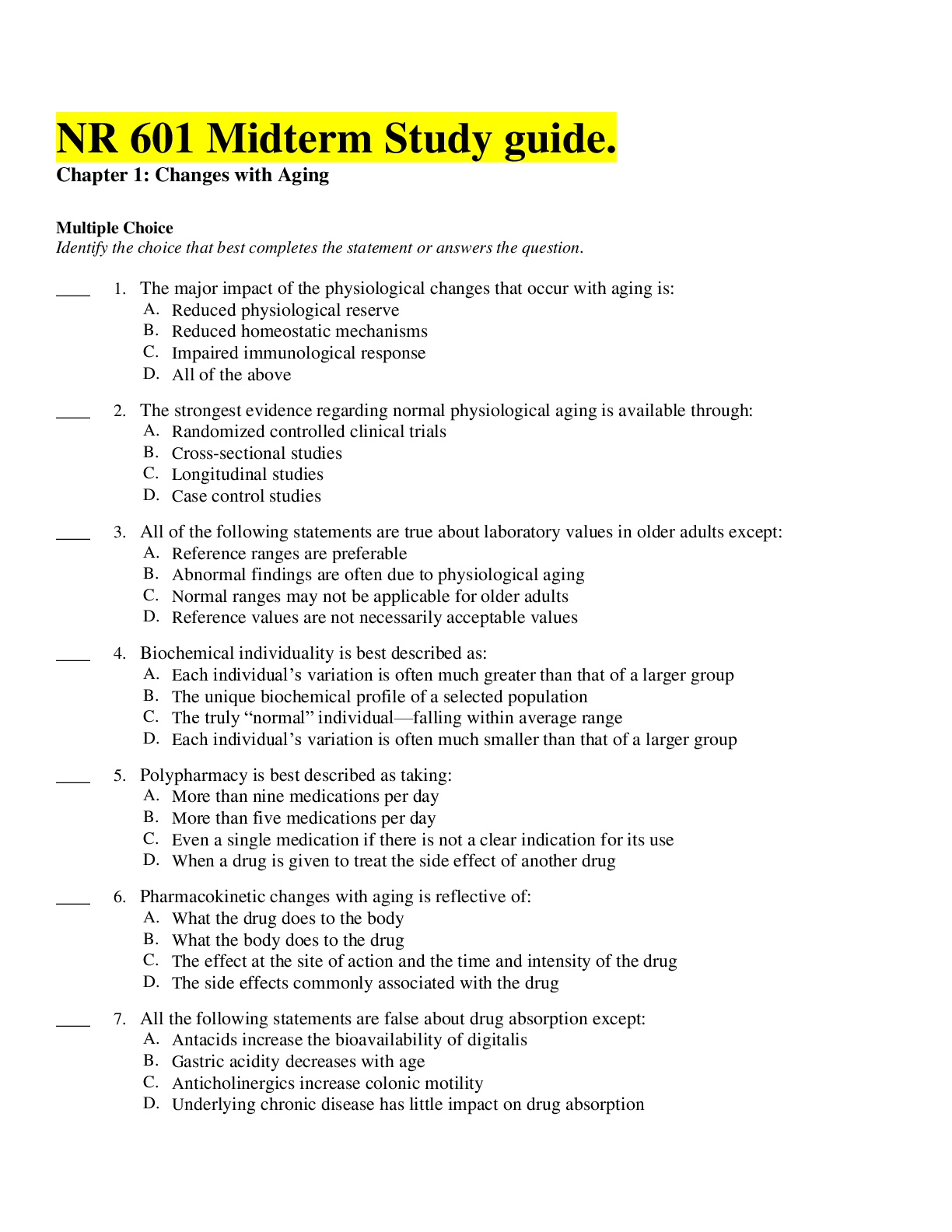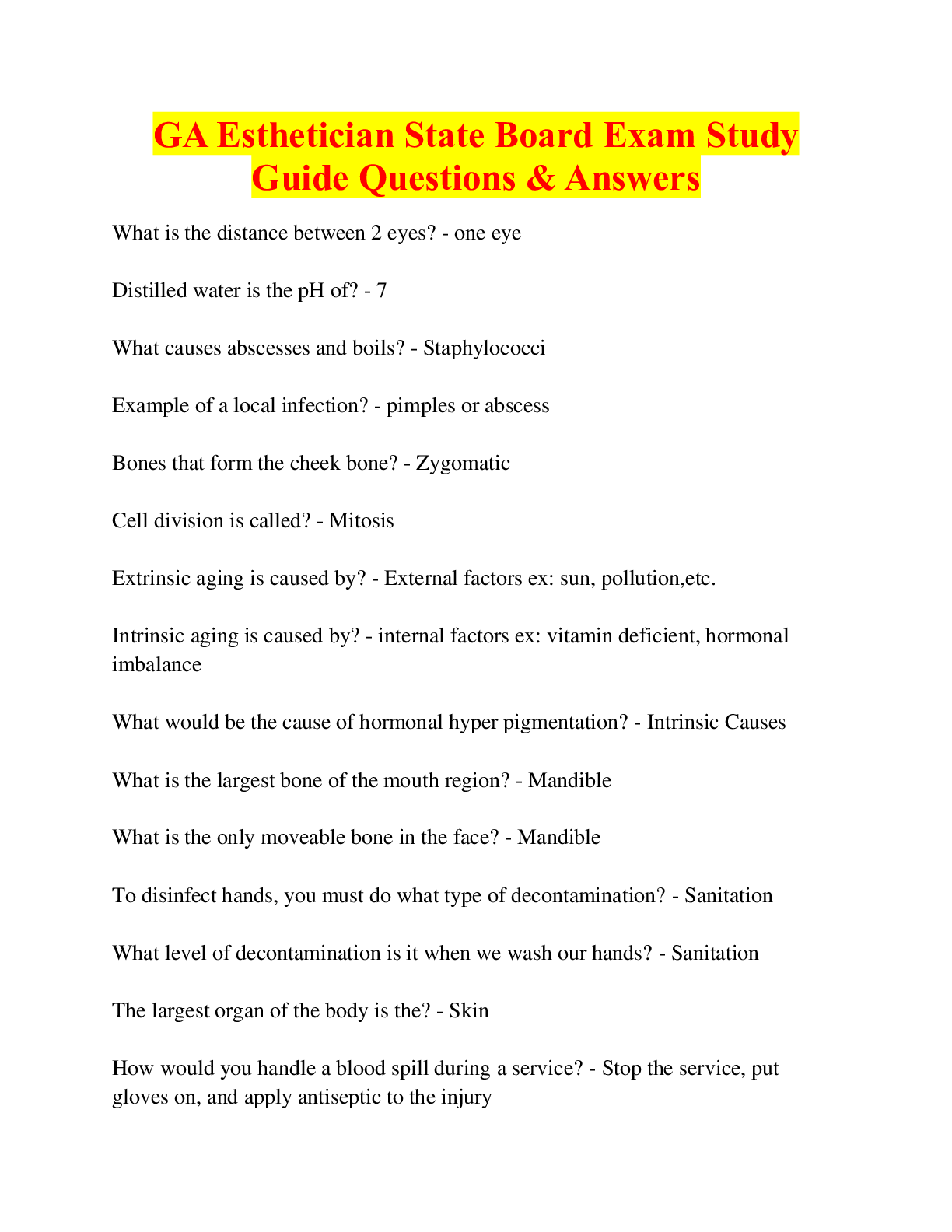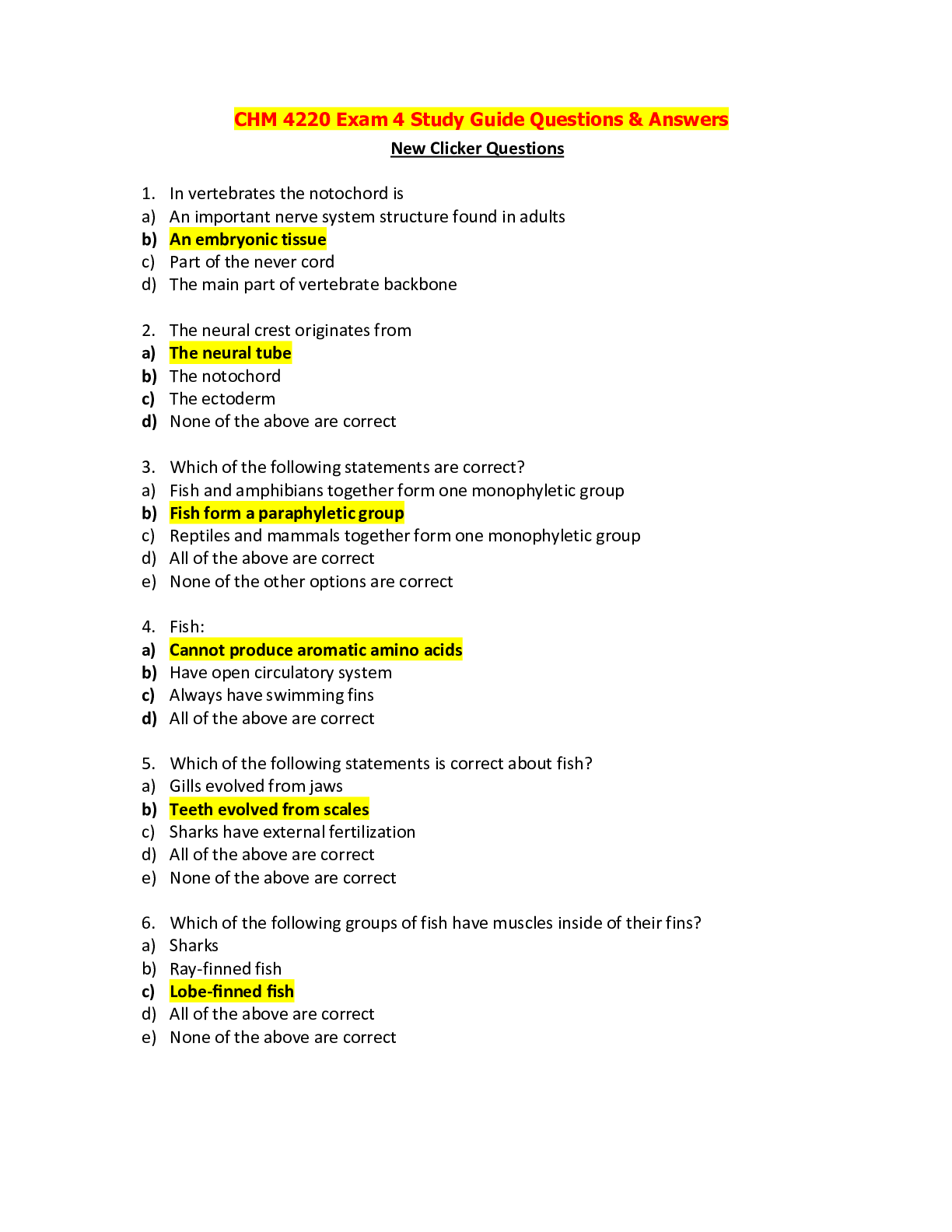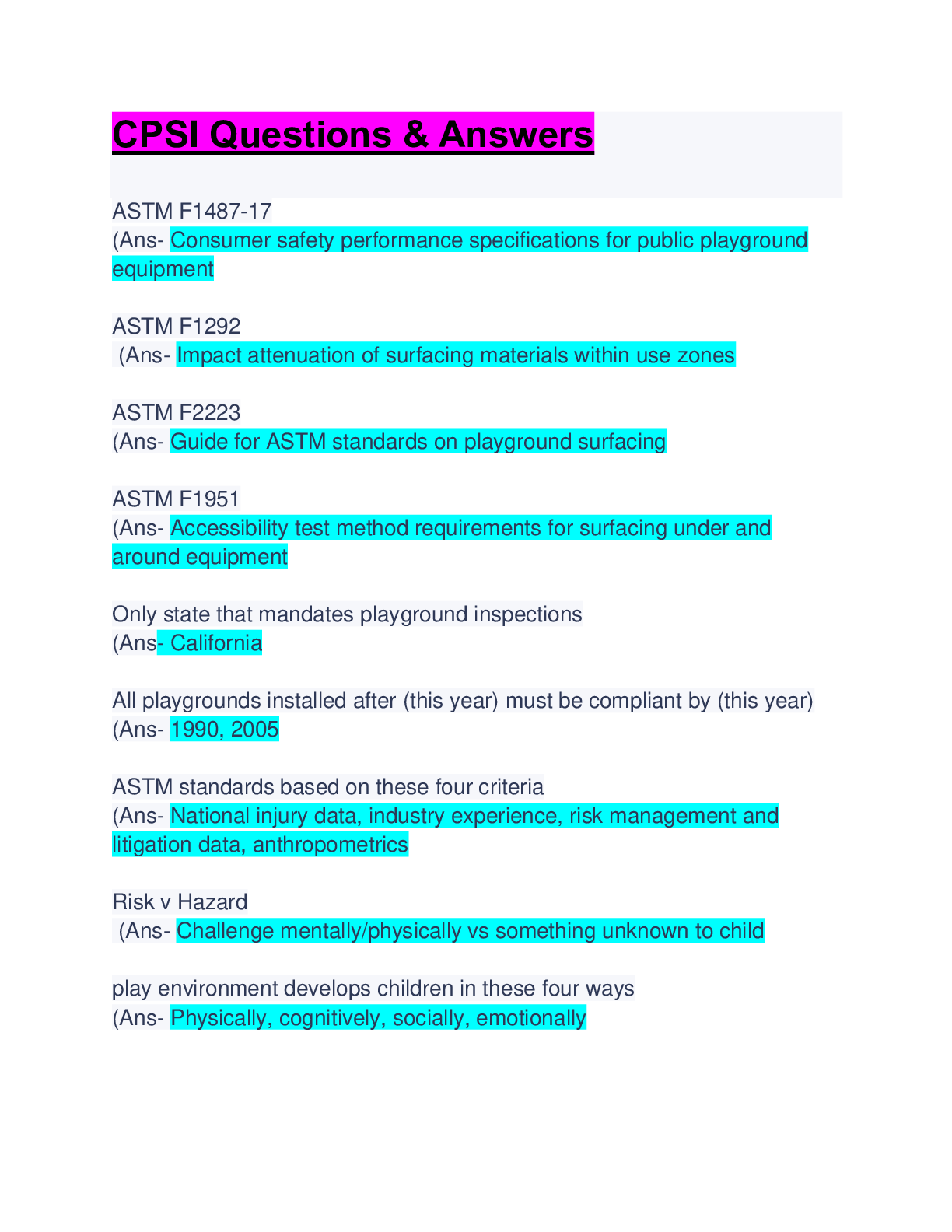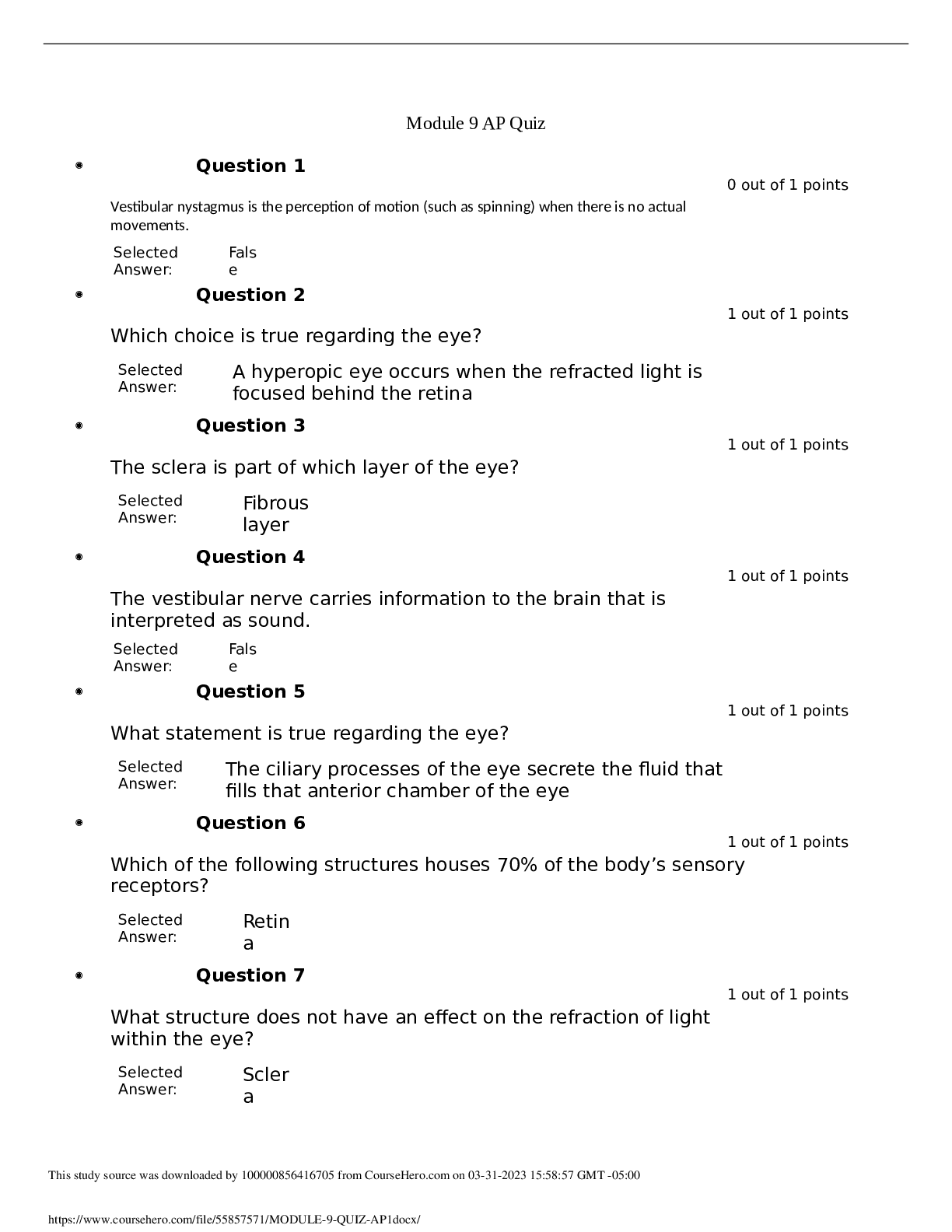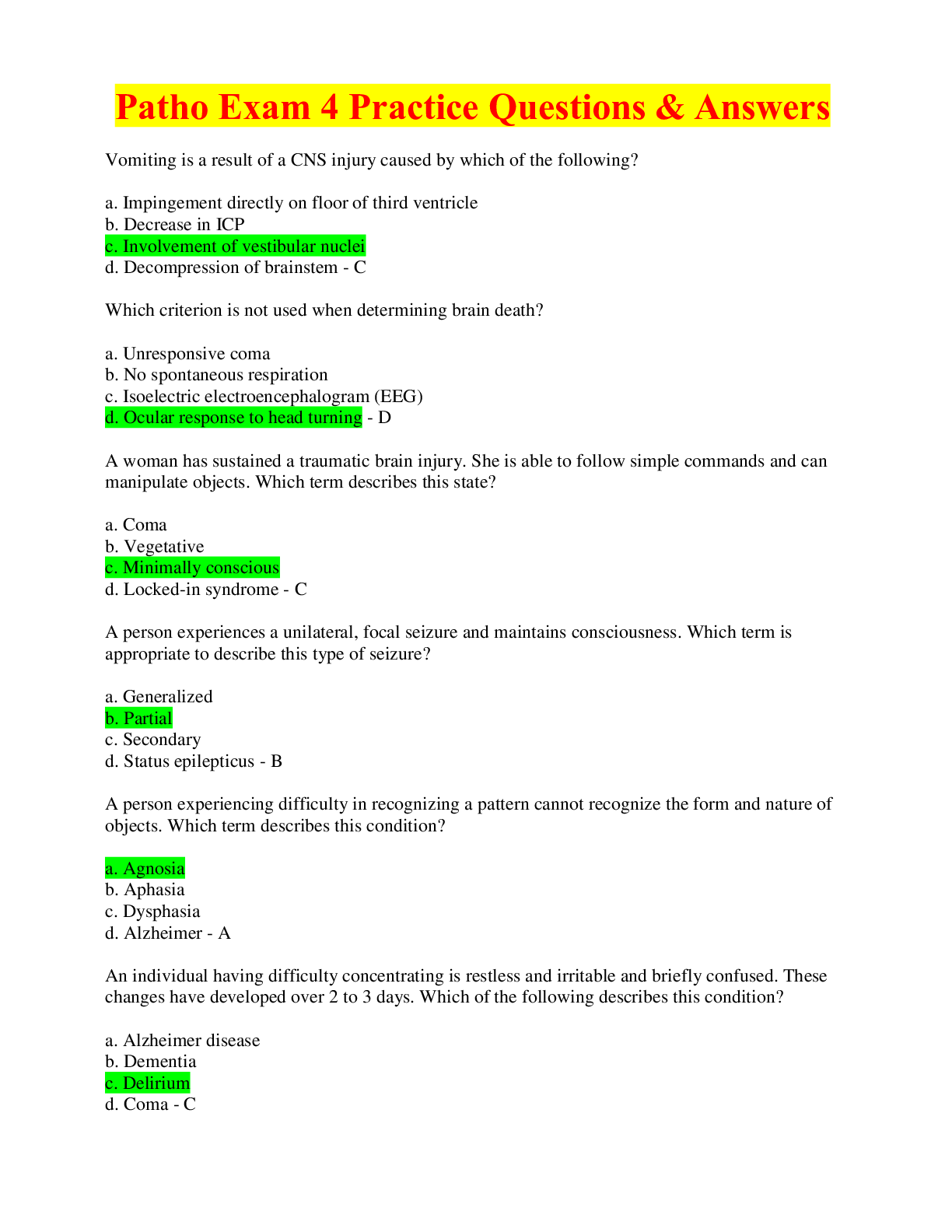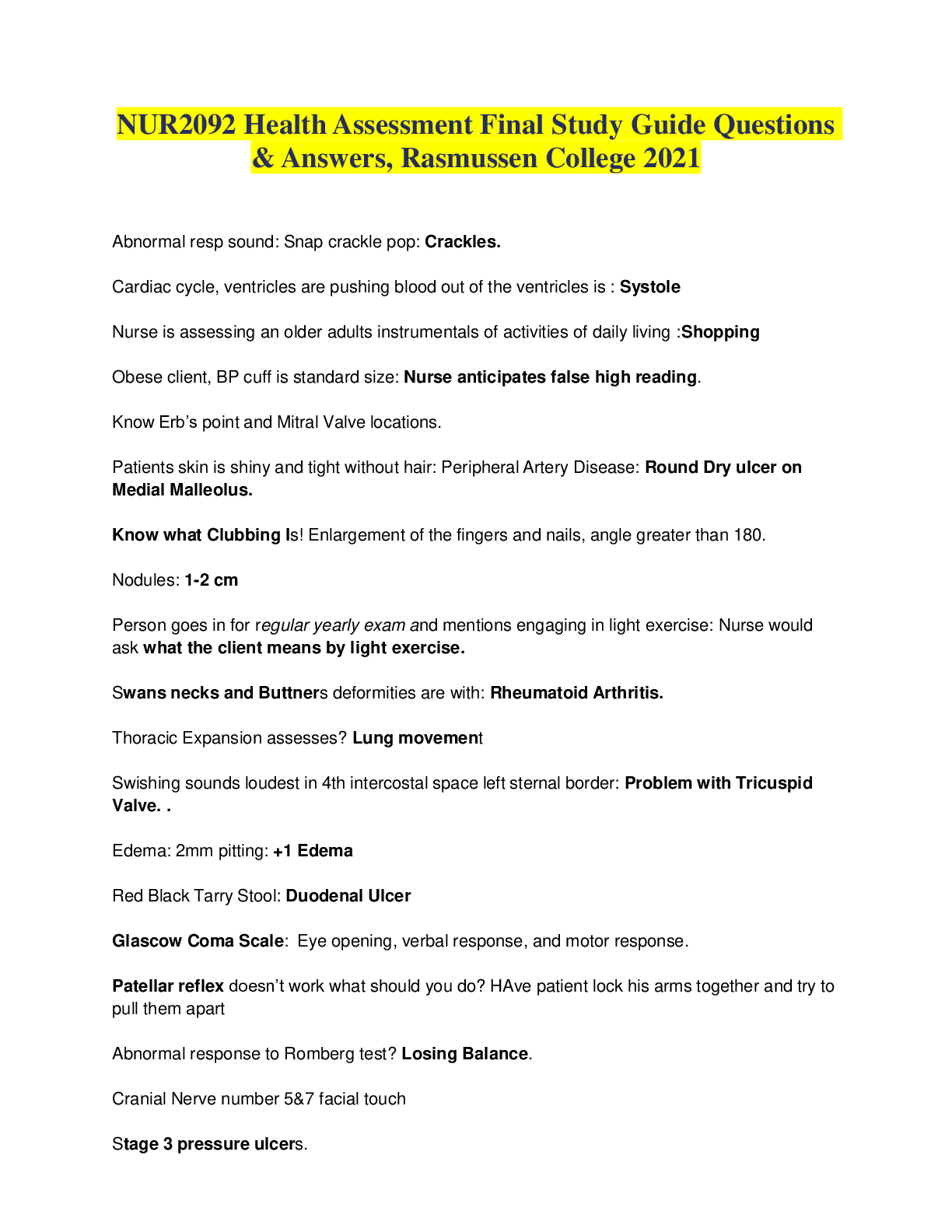*NURSING > STUDY GUIDE > NUR2092 Health Assessment Final Study Guide Questions & Answers, Rasmussen College 2021 (All)
NUR2092 Health Assessment Final Study Guide Questions & Answers, Rasmussen College 2021
Document Content and Description Below
NUR2092 Health Assessment Final Study Guide Questions & Answers. Abnormal resp sound: Snap crackle pop: Crackles. Cardiac cycle, ventricles are pushing blood out of the ventricles is : Nurse is assess... ing an older adults instrumentals of activities of daily living : Obese client, BP cuff is standard size: Know Erb’s point and Mitral Valve locations. Patients skin is shiny and tight without hair: Peripheral Artery Disease: Is! Enlargement of the fingers and nails, angle greater than 180. Nodules Person goes in for regular yearly exam and mentions engaging in light exercise: Nurse would ask deformities are with: Thoracic Expansion assesses? Swishing sounds loudest in 4th intercostal space left sternal border: Edema: 2mm pitting: Red Black Tarry Stool: Eye opening, verbal response, and motor response. doesn’t work what should you do? HAve patient lock his arms together and try to pull them apart Abnormal response to Romberg test? Cranial Nerve number 5&7 facial touch Stage 3 pressure ulcers. Deep Tendon reflexes: Fracture picture: Know the difference Know about is ringing buzzing crackling in ear. is crunching grating sound of clients knee. Rashes: Vertigo is….. What is the last thing a culture gives up when adapting to a new culture? Patient has N and in. Expect to find pain on percussion Primary secondary tertiary. …. …. Tests for Gross hearing ability. Skin color is included in Non Modifiable colon cancer risk factor is: Dorsiflexion is ….. Diagnosis with Pneumonia …. Nurse can clearly hear 99 in left lower lobe __________________________________________________________________________ Kahoot: 1. What occurs in the diagnosis step of the nursing process? 2. Which Statement will elicit the most information? 3. What are the characteristics of lymph nodes in clients with 4. A client has a left femur fracture repair, which is of the most concern to the nurse? 5. What is a symptom of 6. How does the nurse document raised 0.6 cm, firm lesion noted on a client’s arm? 7. Where can bronchial breath sounds be heard? 8. 58 year old finds small lump in breast, what data history 9. Which assessment is appropriate for evaluating cerebellar function? 10. Perform spinal assessment and note excessive inward curvature of the lumbar spine, this is: 11. What is a sign of right sided congestive heart failure: 12. A raised firm lesion almost 4 cm: 13. What order does nurse auscultate heart valves? 14. Assessing ROM clients ankles nurse expects client to perform 15. Which guideline may be used to identify which heart sounds is S1? 16. Heberden and Bouchard nodes are associated with what condition? 17. What does tactile fremitus assess? 18. Swooshing sounds loudest at 2nd intercostal space, Rt border. Problem valve? 19. Romberg: Pt sways and moves feet farther apart. Document? 20. Pt s/s: severe headache, vomiting and rash. Nurse would suspect 21. Common change seen in geriatric clients? 22. What is an appropriate tool to evaluate pain on a 5 year old with a broken arm? 23. Muscle is relaxed and part? ROM 24. Heard loudest at 2nd intercostal space, Rt and Left of sternal borders 25. s/s nurse considers cataracts as diagnosis eye 26. Ausculates ABD aorta, hears swishing sound. Nurse suspects? 27. 50 year old to have colonoscopy. What level of health promotion is this? 28. What is a non-modifiable colon cancer risk factor? 29. Tongue movement and tongue strength. This tests cranial nerves? PRACTICE QUESTIONS: 1. The nursing student is learning blood pressure techniques and asks the instructor what is a normal blood pressure reading? Which of the following would be appropriate response for the instructor? (c) a. Ask the client what is usual for them b. A normal reading is 140/80 c. Normal is considered to be less than 120/80 and above 100/60 d. “That depends on the client” 2. “A 65yr old man with emphysema and bronchitis ahs come to the clinic for a follow up appointment. On assessment of his skin the nurse might expect to find the following. (a) a. Clubbing of the nails b. Scleroderma c. Pedal erythema d. anasarca 3. When the client’s chart includes a notation that Petechiae have been observed, what finding does the nurse expect during inspection? (a) a. Purplish-red pinpoint lesions b. Deep purplish or red patches of skin c. Small raised fluid-filled pinkish nodules d. Generalized reddish discoloration of an area of skin 4. Which of the following situations will result in a falsely high blood pressure? Select all that apply (a,c.) a. The blood pressure cuff is too narrow for the extremity. b. The cuff has a small tear on the side of it c. The person is sitting with his or her legs crossed d. The nurse does not inflate the cuff high enough. 5. The nurse is assessing capillary refill on a client and notes a color return that takes 4 seconds on each hand. The nurse would correctly document this finding as which of the following? (b) a. Normal b. Sluggish c. Absent d. Brisk 6. The nurse has discovered decreased skin turgor in a patient and nows that this in an expected finding in which of the following conditions? (C) a. During childhood growth spurts b. Cases of severe obesity c. An individual who is severely dehydrated d. With conditions of connective tissue disorders such as scleroderma 7. A Mother brings her newborn in for an assessment and asks, “Is there something wrong with my baby? His head seams so big.” The nurse knows the following about relative portions of the head and trunk of the newborn. (A) a. HEad circumference should be greater than chest circumference at bitrh. b. At birth, the head is one fifth the total length c. The head size reaches 90% of its final size when the child is 3 y.o d. When the anterior fontanel closes at 2 months, the head will be more proportioned to the body. 8. The Nurse educator is preparing an education module for the nursing staff on the epidermal layer of skin. Which of the following would be included in the module? (A) a. The epidermis is replaced every 4 weeks b. The epidermis is very vascular c. The epidermis is thick and tough d. The epidermis is thin and non stratified 9. The nurse is assessing a patient’s pain. The nurse knows that which of the following is considered the most reliable indicator of pain? (B) a. Vital Signs, b. The subjective report c. The physical Examination d. Computerized axial tomography scan finding. 10. The nurse is aware that the four areas of the body where lymph nodes are accessible are the: (D) a. Head, breasts, groin, and abdomen. b. Arms , breasts, inguinal area, and legs c. Head and heck, arms, inguinal area, and axillae d. Head, neck, arms, inguinal area, and axillae 11. To assess for jaundice the nurse would inspect for: (B) a. Ashen-gray color in the oral mucosa membranes b. Yellow pigmentation in the sclera c. Very pale skin on the palms d. Bluish color in the axilla and groin 12. A 4y.o boy is brought to the ER by his mother. She states that he points to his stomach and says “It hurts so bad.” Which pain assessment tool would be the best choice for when assessing this child’s pain? (C) a. The number rating scale b. The descriptor scale c. The Wong-Baker scale d. The brief pain inventory 13. When the nurse assesses an apical heart rate and notes bradycardia. What do you expect the apical heart rate to be? (D) a. Greater than 100/minute b. 60-90 BPM c. Greater than 150/minutes d. Less than 60 BMP 14. A 50 y.o. Woman with elevated serum, total cholesterol, and triglyceride level is visiting the clinic today to find out about her laboratory results. What would be important for the nurse to include in the patient teaching in relation to these tests. (A) a. Information regarding a low saturated fat diet b. The risks of undernutrition c. Methods to reduce stress in her life d. The fact that this is hereditary and there is nothing she can do to change the levels. 15. The nurse is performing a nutritional assessment on an 80 y.o patient The nurse knows that physiologic changes that directly affect the nutritional status of the elderly include: (A) a. Slowed gastrointestinal motility. b. Hyperstimulation of the salivary glands c. An increased sensitivity to spicy and aromatic foods d. Increased GI absorption causing esophageal reflux. 16. Which of the following findings should the nurse expect to find when assessing the nails of a healthy adult. (C) a. The nail base angle is not more than 90 degrees b. Whitish to clear nails in darker skinned clients. c. Smooth and rounded nails with a flat surface. d. Gradual enlargement of the distal finger. 17. A Patient's laboratory data reveal an elevated thyroxine level. The nurse would proceed with an examination of the: (B) a. Parotid Gland b. Thyroid Gland c. Adrenal Gland d. Thyroxine Gland 18. All of the following data is collected during the head-to-toe assessment except: (C) a. Mood or affect b. Hearing and Speech abilities c. Laboratory results d. Gait 19. During a nutritional assessment why is it important for the nurse to ask a patient what medications he or she is taking? (B) a. The nurse needs to assess the patient for allergic reactions b. Certain drugs can affect the metabolism of nutrients c. Medications need to be documented on the record for the physician’s review. d. Medications can affect one’s memory and ability to identify food eaten in the last 24 hours 20. A Client reports a rash that “Itches” but denies fever, SOB, or other symptoms. What does the nurse ask to help determine if the client is experiencing an allergic reaction? (A,B,D) a. Are you taking any new medications? b. Have you been using any different soaps? c. Is your skin unusually dry or flaky? d. Have you been exposed to any new cleaning solutions? e. Have you noticed any new bruises or brownish discoloration? 21. An older adult woman is brought to the ER after being found lying on the kitchen floor for 2 days. She is extremely dehydrated. What would the nurse expect during the examination? (D) a. White patches on the mucous membranes b. Smooth mucous membranes and lips c. Pale mucous membranes d. Dry mucous membranes and cracked lips. 22. Which of the following statements is true regarding the use of standard precautions in the healthcare setting? (A) a. Standard precautions are intended for use with all patients regardless of their risk or presumed infection status. b. Standard precautions apply to all body fluids, including sweat c. Airborne, droplet, and contact transmission-based precautions are included in the use of standard precautions d. Standard precautions are to be used only when there is non intact skin, excretions contain visible blood, or contact with mucous membranes is expected. 23. A patient’s thyroid is enlarged and the nurse is preparing to auscultate the thyroid for the presence of a bruit. A Bruit is a: (B) a. High pitched tinkling sound best heard with the diaphragm of the stethoscope b. Soft whooshing sound, pulsatile sound best heard with the bell of the stethoscope c. Low gurgling sound best heard with the diaphragm of the stethoscope d. Loud, whooshing, blowing sound best heard with the bell of the stethoscope 24. A Client came for their yearly health assessment provided by their employer. You are reviewing their heart history. The client mentions that they engages in light exercise. At the time you should do which of the following (B) a. Record “light” exercise b. Ask what the client means by “light exercise” c. Record that the client “walks each day” d. Ask if the client does their own house cleaning. 25. During an examination, the nurse finds that a patient has excessive dryness of the skin. The best term to describe this condition is: (A) a. Xerosis b. Alopecia c. Pruritus d. Seborrhea 26. Which technique of assessment used to determine the presence of crepitus, swelling, and pulsations? (C) a. Inspection b. Auscultation c. Palpation d. Percussion 27. In a report, the nurse learns that a client has macular rash. Which of the following best describes a macular rash? (D) a. Elevated firm, well defined lesions less than 1 cm in diameter b. Depressed, firm, or scaly, rough lesions greater than 1 cm in diameter c. Elevated, fluid filled lesions less than 1 m in diameter d. Flat, well defined small lesions less than 1 cm in diameter? 28. When evaluating a patient's pain, the nurse knows that an example of acute pain would be: (D) a. Low back pain b. Arthritic Pain c. Fibromyalgia d. Kidney Stones 29. When documenting the palpation of a pulse, the nurse is correct in recording which of the following about the rhythm? (B) a. Rhythm 100 BPM b. Irregular Rhythm c. Rhythm noted at 2 d. Bounding Rhythm 30. A patient is especially worried about an area of skin on her feet that has turned white. The health care provider has told her that her condition is vitiligo. The nurse explains to her that vitiligo is: (C) a. Caused by an excess of apocrine glands in her feet b. Caused by an excess of melanin pigment c. Caused by the complete absence of melanin pigment d. Related to impetigo and can be treated with ointment 31. When assessing a patient’s nutritional status, the nurse recalls that the best definition of optimal nutrition status is: (A) a. Sufficient nutrients to provide for daily body requirements and for increased metabolic demands. b. Nutrients in excess of daily body requirements c. Sufficient nutrients to provide for the minimum body needs. d. Sufficient nutrients for daily body requirements but not for increased metabolic demands A black patient is in the intensive care unit because of impending shock after an accident. The nurse expects to find what characteristics in this patient’s skin? (B) A. Ruddy blue B. Ashen, gray or dull C. Patchy areas of pallor D. Pale with blue extremities When auscultating the right carotid artery, the nurse hears a swishing sound (a bruit). What would this suggest?(D) A. Decreased cardiac output B. Increased central venous pressure C. Right ventricular failure D. A narrowed vessel During the aging process, the hair can look gray or white and begin to feel thin and fine. The nurse knows that this occurs because of a decrease in the number of functioning (D) A. Phagocytes B. Fungacytes C. Metrocytes D. Melanocytes A patient, 85 yr. old women, is complaining about the fact the bones in her face have become more noticeable. What explanation should the nurse give her? (B) A. Diets low in protein and high in carbohydrates may cause enhanced facial bones B. More noticeable facial bones are probably due to a combination of factors related to aging, such as decreased elasticity, subcutaneous fat, and moisture in her skin C. Bones can become more noticeable if the person does not use a dermatologically approved moisturizer. D. Facial skin becomes more elastic with age. This increased elasticity causes the skin to be more taught, drawing attention to the facial bones The nurse is assessing a patient with a heart rate of 55. Which of the following patients would be most likely to have a pulse rate of 55? (C) A. A 70-year-old telephone salesman who is dehydrated. B. A 67-year-old who presented with an exacerbation of his COPD C. A 20-year-old runner who had surgery 4 days ago for a fractured leg D. And infant who has a temperature of 100.1 degrees F. Physical growth is the best index of a child’s (B) A. General makeup B. General health C. Nutritional status D. Activity and exercise patterns Which of the following factors is most likely to affect the nutritional status of an 82-year-old person? (D) A. Increase in gastrointestinal motility and absorption B. Increase in taste and smell C. Change in cardiovascular status D. Living alone on a fixed income During an examination, a nurse notes a lesion on the client’s upper back. What is the best way to document the size of this lesion? (A) A. Use a centimeter rule to measure the lesion B. Compare its size to the size of a coin C. Estimate its size to the nearest inch D. Trace the lesion onto a piece of paper When performing a physical assessment, the technique the nurse will always use first is (A) A. Inspection B. Palpation C. Percussion D. Auscultation A newborn infant is in the clinic for a well-baby checkup. The nurse observes the infant for the possibility of fluid loss because of which of these factors? (B) A. Subcutaneous fat deposits are high in the newborn B. The newborn's skin is more permeable than that of the adult C. Sebaceous glands are over productive in the newborn D. The amount of vernix caseosa dramatically rises in the newborn When examining the face, the nurse is aware that the two pairs of salivary glands that are accessible to examination are the ________ glands (A) A. Parotid and jugulodigastric B. Occipital and submental C. Occipital and submental D. Parotid and submandibular The nurse notices that an infant has a large, soft lump on the side of his head and that his mother is very concerned. She tells the nurse that she noticed the lump approximately 8 hours after her baby’s birth and that it seems to be getting bigger. One possible explanation for this is (D) A. Caput succedaneum B. Craniosynostosis C. Hydrocephalus D. Cephalohematoma A thorough skin assessment is very important because the skin holds information about (A) A. Psychological wellness B. Support systems C. Socioeconomic status D. Circulatory status When assessing the radial pulse of a patient, the nurse should count the (A) A. Pulse for 1 minute if the rhythm is irregular B. Pulse for 15 seconds and multiply by four, if the rhythm is regular C. Initial pulse for a full 2 minutes to detect any variation in amplitude D. Pulse for 10 seconds and multiply by six, if the patient has no history of cardiac abnormalities The nurse detects a possible irregularity in the rhythm of a client’s radical pulse. Which of the following should the nurse perform? (C) A. Record this as normal for the client B. Count the radical pulses again for 15 seconds and multiply by 4 C. Count the client’s apical pulse for a full minute D. Use a stethoscope to check the brachial pulse A nurse notices multiple lesions on a client’s back that are 0.5 cm in width, elevated, circumscribed and filled with serous fluid. The nurse documents these lesions as: (C) A. Macules B. Patches C. Vesicles D. Bullae When documenting the results of palpating the pulse, the nurse is correct in making which of the following notations? (C) A. Rhythm noted at 2 B. Rhythm 110 beats/minute C. Irregular rhythm D. Bounding contour The nurse is performing an assessment on an older adult client. Which assessment data would indicate a potential complication associated with the skin of this client? (B) A. Wrinkling B. Lesion with an irregular border C. Deeping of expression lines D. Thinning and loss of elasticity in the skin A patient states that the pain medication is not working and rates his postoperative pain at a 10 on a 1 to 10 scale. Which of the following assessment findings indicates an acute pain response to poorly controlled pain? (D) A. Decreased blood pressure and pulse B. Confusion C. Hyperventilation D. Increased blood pressure and pulse A mother brings her 2-month-old daughter in for an examination and says. My daughter rolled over against the wall, and now I have noticed that she has this spot that is soft on the top of her head. Is something terrible wrong? The nurse’s best response would be? (A) A. The soft spot is normal, and actually allows for growth of the brain during the first year of your baby’s life B. Your baby may have craniosynostosis, a disease of the sutures of the brain C. Perhaps that could be a result of your dietary intake during pregnancy D. That soft spot may be an indication of cretinism or congenital hypothyroidism The nurse is bathing an 80-year-old man and notices that his skin is wrinkled, this, lax, and dry. This filming would be rated to which factor in the older adult? (D) A. Increased vascularity of the skin B. An increased loss of elastin and a decrease in subcutaneous fat C. Increased numbers of sweat and sebaceous glands D. An increase in elastin and decrease in subcutaneous fat Which of the following clients has the greatest risk of developing hypertension? (C) A. Clients with high cholesterol levels B. Hispanic men C. Obese men with diabetes mellitus D. Postmenopausal women A woman is leaving on a trip to Hawaii and has come in for a checkup. During the examination the nurse learns that she has diabetes and takes oral hypoglycemic agents. The patient needs to be concerned about which possible effect of her medications? (B) A. Increased possibility of bruising B. Importance of sunscreen and avoiding direct sunlight C. Skin sensitivity as a result of exposure to salt water D. Lack of availability of glucose-monitoring supplies The nurse needs to take the blood pressure of a thin white female but only a large cuff available. The nurse would correctly anticipate which of the following readings? (B) A. A falsely elevated reading B. A falsely low reading C. An accurate reading D. The size of the cuff doesn’t make any difference The nurse knows that which statement is true regarding the pain experienced by infants? (A) A. A procedure that induces pain in adults will also induce pain in the infant B. Pain in infants can only be assessed by physiologic changes, such as increased heart rate C. The Wong-Baker scale can be used to assess pain in infants D. Infants feel pain less than adults do During assessment of patient’s pain, the nurse keeps in mind that certain nonverbal behaviors are associated with acute pain. Which of the following behaviors are associated with acute pain? (Select all that apply) (C, D)=cd A. Sleeping B. Smiling C. Moaning D. Diaphoresis During an interview, the nurse is discussing dietary habits with a client. Which tool would be the best choice to use as a quick screening tool to assess dietary intake? (C) A. Calorie count B. Food diary C. 24-hour recall D. Comprehensive diet history A client reports the mole on his scalp has started itching and it bleeds when he scratches it. What other finding would be a danger sign for pigmented skin lesions? (A)=b A. Symmetry of the lesion B. Irregular border C. Color consistency D. Size less than 6 mm wide A 75-year-old woman who has a history of diabetes and peripheral vascular disease has been trying to remove a corn on the bottom of her foot with a pair of scissors. The nurse will encourage her to stop trying to remove the corn with scissors because: (C) A. With her peripheral vascular disease, her range of motion is limited and she may not be able to reach the corn safely B. She is 75 years old and is unable to see; consequently, she places herself at greater risk for self-injury with the scissors C. The woman could be at increased risk for infection and lesions because of her chronic disease D. With her diabetes, she has increased circulation to her foot, and it could cause severe bleeding The best way to assess the general temperature of the skin is for the nurse to use which part of the hand? (D) A. Palmar surface (underside) of the hand B. Pads of the fingers C. Ulnar surface of the hand D. Back (dorsum) of the hand The nurse is assessing the skin of the client who is at risk for dehydration due to excessive vomiting. The skin appears dry and loose. Where is the best site for the nurse to check skin turgor on this client? (C) A. Mid-thigh B. Upper arm C. Anterior chest D. Facial cheek When performing a general survey, the examiner is (A) A. Observing the patient’s body stature and nutritional status B. Interpreting the subjective information, the patient has reported C. Observing specific body systems while performing eh physical assessment D. Measuring the patient’s temperature, pulse, reparations, and blood pressure What is being tested when the client is being assessed utilizing a Snellen chart? (B) A. Ability to read or see items in close proximity B. Ability to see items from a distance C. Papillary reaction D. Accommodation A patient tells the nurse that he has noticed that one of his moles has started to burn and bleed. When assessing his skin, the nurse pays special attention to the danger signs for pigmented lesions and is concerned with which additional finding? (A)=d A. Symmetry lesions B. Diameter of less than 6 mm C. Border regularity D. Color variation A patient is crying and says, “Please get me something to relieve this pain.” What should the nurse do next? (A) A. Assess the level of pain and ask patient what usually works for his or her pain, administer pain medication as needed, then reassess pain level B. Assess the level of pain and give medications according to pain level, and then reassess pain C. Reposition the patient, then reassess the pain after intervention D. Confirm that the patient has an order for pain medications and administer order as directed. Which statement indicates that the nurse understands the pain experience in the elderly? (A) A. Pain indicates pathology or injury and is not a normal process of aging B. Older persons must learn to tolerate pain C. Older individuals perceive pain to a lesser degree than younger individuals D. Pain is a normal process of aging and is to be expected The nurse is assessing the vital signs of a 3-year-old patient who appears to have an irregular respiratory pattern. How should the nurse assess this child’s respirations? (A) A. Count the respirations for a full minute, noting rate and rhythm. B. Check the child’s pulse and respirations simultaneously for 30 seconds C. Check the child’s respirations for a minimum of 5 minutes to identify any variations in respiratory pattern D. Count the patient’s respirations for 15 seconds and multiply by four to obtain the number of respirations per minute. When assessing a patient’s pain, the nurse know that an example of visceral pain would be (A) A. Cholecystitis B. Hip fracture C. Second degree burns D. Pain after a leg amputation The nurse is preparing to percuss to assess the underlying (D) A. Tissue consistency B. Tissue turgor C. Tissue texture D. Tissue density Which of the following statements is true concerning the nutritional assessment? (D) A. It provides the nurse with physical findings related to all systems B. This assessment can only be thoroughly done by a dietician C. It is only useful in patients who are overweight D. It identifies patients who are at risk of malnutrition To accurately assess the carotid pulse the nurse would do which of the following? (A) A. Palpate in the groove between the trachea and the right and left sternocleidomastoid muscles one side at a time B. Place two fingers of each hand firmly over the right and left temple at the same time C. Place the fingers gently in the space between the triceps and the biceps muscles D. Visualize the pulsation at the jugular angle Which of the following is true regarding the stethoscope and its use? (C) A. The ideal rubbing length should be 22 inches long to dampen distortion of sound. B. The slope of the earpieces should point posteriorly (toward the occiput) C. The fit and quality of the stethoscope are not as important as its ability to magnify sound. D. The stethoscope does not magnify sound but does block out extraneous room noise. A client presents with small, elevated superficial lesions with purulent fluid and the nurse records these lesions as which of the following? (C) A. Cysts B. Bullae C. Pustules D. Wheal When assessing a patient’s pulse, the nurse should note which of the following characteristics? (B) A. Pallor B. Force/amplitude C. Capillary refill time D. Timing in the cardiac cycle KAHOOT IT QUESTIONS FROM CLASS: Tongue movement and tongue strength. Which cranial nerve is being tested? (D) A. IX, glossopharyngeal B. VII, facial C. X, vagus D. XII, hypoglossal What is a non-modifiable colon cancer risk factor? (D) A. Smoking B. Alcohol use C. Obesity D. African American 50 year old to have colonoscopy. What level of health promotion is this? (C) A. Primary prevention B. Tertiary C. Secondary prevention D. Risk factor prevention Ausculates ABD aorta, hears swishing sound. Nurse suspects? (D) A. Nothing, it’s normal finding B. Myocardial infarction C. Aortic stenosis D. An aneurysm S/S nurse considers cataract as diagnosis? (A) A. Clouding of the lens of the eye B. Complaint of seeing red rings around lights C. Purulent discharge D. Eye pain Hear loudest in 2nd intercostal space RT & Left of sternal boarders (A) A. S2 B. S1 C. Thrill D. Murmur Muscle is relaxed and nurse moves body part? (B) A. Active ROM B. Passive ROM C. Abduction D. Atrophy What is appropriate tool to evaluate pain on a 5 year old broken arm? (D) A. 0-5 numeric rating scale B. Simple pain descriptor C. NIPS scale D. Wong Baker faces pain scale Common change seen in geriatric clients? (A) A. Skin thins due to loss of collagen B. Hair becomes more abundant C. Blood pressure decreases due to decreased vessel elasticity D. Heart beat usually slows with age Pt s/s severe headache, vomiting and rash. Nurse would suspect meningitis? (C) A. The client has upper respiratory symptoms B. The client has a resting tremor C. The rash does not blanch with pressure D. The client has seizures Romberg: Pt sways and moves feet farther apart. Document? (B) A. Normal B. Positive Romberg sign C. Lack of coordination D. Negative Homan’s sign Swooshing sound loudest 2nd intercostal space, Rt. Border. Problem valve? (D) A. Tricuspid B. Mitral C. Pulmonic D. Aortic What does tactile fremitus assess? (A) A. Difference in density of lung tissue B. Breath sounds C. Firmness of skin tissue D. Symmetry of lung inflation Herberden & Bouchard nodes are associated with what condition? (D) A. Dupuytren contracture B. Rheumatoid arthritis C. Gout D. Osteoarthritis What guideline may be used to identify which heart sound is S!? (B) A. S1 is louder than S2 at base of heart B. S1 coincides with the carotid artery pulse C. S1 coincides with A wave of the jugular venous pulse wave D. S1 coincides with the Q wave of the QRS EKG. Assessing ROM client’s ankles nurse expects client to perform? (B) A. Supine & extension B. Dorsiflexion and inversion C. Circumduction and peonation D. Extension and hyperflexion What order does nurse ausculate heart valves? (B) A. Aortic, tricuspid, mitral, pulmonic B. Aortic, pulmonic, tricuspid, mitral C. Mitral, tricuspid, pulmonic, aortic D. Tricuspid, mitral, aortic, pulmonic A raised firm lesion almost 4 cm. Nurse documents? (C) A. Vesicle B. Nodule C. Tumor D. Wheal What is a sign of right sided congestive heart failure? (C) A. Orthopnea B. Moist skin C. Jugular venous distention D. Fever Perform spinal assessment and note excessive inward curvature of lumbar spine. (C) A. Kyphosis B. Scoliosis C. Lordosis D. Spondylosis Which assessment would be appropriate for evaluating cerebellar function? (C) A. Dull or sharp testing B. Testing cranial nerve X, Vagus C. Rapid alternating fingers D. Stereognosis 58 yr old finds small lump in breast What data history risk factor breast cancer? A. Her husband’s mother died from breast cancer B. She has wine every evening C. She had radiation Tx for Hodgkin’s disease at age 17 D. Menarche occurred at age 14, menopause at 46 Where can bronchial breath sounds be heard? (B) A. Peripheral lung fields B. Tracheal area C. Sternal area D. Between the scapula How does nurse document a raised 0.6 cm, firm lesion noted on a client’s arm? (A) A. Papule B. Wheal C. Nodule D. Macule What is a symptom of nephrolithiasis? (A) A. Flank pain B. Indigestion C. High fever D. Blood in the stool A client has a left femur fracture repair. Which is of most concern to the nurse? (C A. Pulse are 1 bilaterally B. Capillary refill of less than 2 seconds C. Left foot is cool and pale D. Swelling at the break site What are the characteristics of lymph nodes in clients with an acute infection? (A) A. Enlarged and tender B. Hard fixed and painless C. Round, rubbery and mobile D. Soft, mobile and painless Which statement will elicit the most information? (B) A. Did you try home remedies for your symptoms? B. What are your symptoms today? C. Didn’t you call your doctor? D. Did you drive yourself today? What occurs in the diagnosis step of the nursing process? (D) A. Assess & plan B. Evaluating goal achievement C.Setting goals & selecting interventions D. Clustering and interpreting data A nurse is interviewing a client who was diagnosed with type 2 diabetes mellitus 6 months ago however the client has gained more weight and the blood glucose levels remain high. The nurse suspects that the client is non-compliant with their diet. Which response by the nurse would enhance data collection in this situation? “Tell me, how have you managed with your diet for these past few months?” “You do want to learn how to reduce your blood sugar levels, don’t you? “You need to follow what the doctor has prescribed for you in order to get better.” “Don’t you know anything about diabetes?” Medication administration or procedural errors can be prevented by completing which task? Ensuring the room is temperature controlled Closing the door and curtain Washing your hands Asking the client to give their name and date of birth Which assessments would be appropriate for evaluating cerebellar function? (Select all that apply) Heel to shin test Finger to nose test Rapid alternating fingers Weber test- hearing test Stereognosis- perception by feeling "During a breast health interview, a client states that she has noticed pain in her left breast. The nurse s most appropriate response to this would be:" I would like some more information about the pain in your left breast. Don t worry about the pain; breast cancer is not painful. I would like some more information about the pain in your right breast. Breast pain is almost always the result of benign breast disease and so let’s just ignore it. "In assessing a patients major risk factors for heart disease, which would the nurse want to include when taking a history?" "Smoking, hypertension, obesity, diabetes, high cholesterol" "Work history, hypertension, stress, age" "Personality type, high cholesterol, diabetes, intense exercise" "Sugar consumption, anorexia, diabetes, stress, high cholesterol" The client has continuous tonic spasm of a muscle. Choose the correct term Tetany Tremor Atrophy Myalgia The nurse knows that the incidence of osteoporosis is greatest in which group? White women Black Men Black Women American Indian men If a nurse uses their hand to press down into the abdomen to assess for tenderness, the nurse is performing which technique? Palpation Inspection Auscultation Percussion "During an annual physical exam, a 43-year-old client states that she doesn t perform monthly breast self-examinations. She tells the nurse that she believes that mammograms do a much better job than I ever could to find a lump. The nurse should explain to her that:" Mammography may not detect all palpable lumps. breast self-examination is unnecessary until the age of 50 years. "she is correct, mammography is a good replacement for breast self-examination." she doesn t need to perform breast self-examination as long as a physician checks her breasts yearly. What is the part of the cardiac cycle in which the ventricles are contracting and pushing blood out of the chambers? Systole Diastole Hypotension Symptom "When testing stool for occult blood, the nurse is aware that a false-positive result may occur with:" A large amount of red meat within the last 3 days. absent bile increased fat content increased ingestion of fruit "The nurse notes that a client has had a black, tarry stool and recalls that a possible cause would be:" gastrointestinal bleeding gallbladder disease overuse of laxatives localized bleeding around the anus What area would the nurse listen to if wishing to listen to the tricuspid valve area? Area 1 Area 2 Area 3 Area 4 Area 5 Which is an example of objective data a nurse would collect during a physical examination? The client s radial and pedal pulses The client s stated concern about lack of money for prescriptions The client s complaints of tingling sensations in the feet The client’s mother s statements that the client has been very nervous lately Identify which reflex is being tested in this picture. Answers: Plantar Patellar Triceps Achille’s "To assess the dorsalis pedis artery, the nurse would palpate:" lateral to the extensor tendon of the great toe. behind the knee. over the lateral malleolus. in the groove behind the medial malleolus. During an interview, the client answers questions quietly and appears sad. While answering questions about her marriage, she begins to cry. Which is the nurse’s appropriate response? “Don’t cry. I’ll come back when you’ve settled down.” “I only have a few more questions to go, then I’ll leave you alone for a while. ” “Everyone has ups and downs in their marriage. What problems are you having?” “I see that you are upset. Is there something you’d like to discuss? In which situation should the nurse screen for intimate partner violence (IPV)? When IPV is suspected When a woman has an unexplained injury As a routine part of each health care encounter When a history of abuse in the family is known The client complains of ringing, crackling or buzzing in the ear. Choose the best term. Tinnitus Tympanic Otitis media Pinna A nurse is inspecting the ear canal of an adult client. Which is the best method to move the pinna in order to straighten the ear canal to better visualize the area? There is no need to move the pinna Gently pull the pinna up and back Gently pull the pinna down and back Pull the pinna horizontal to the side of the head The nurse is explaining to a client that there are shock absorbers in his back to cushion the spine and to help it move. The nurse is referring to his: Intervertebral discs Costal Facets Nucleus Pulposus Vertebral foramen A client has hypoactive bowel sounds. The nurse knows that a potential cause of hypoactive bowel sounds is: peritonitis. diarrhea. laxative use. gastroenteritis. The nurse is aware that a change that may occur in the gastrointestinal system of an aging adult is: decreased gastric acid secretion increased salivation megacolon increased esophageal emptying A client asks, “Why is touching my toes necessary? This is a sports physical examination not an exercise class.” How would the nurse reply? “This is the best way to check for symmetry of your arms.” “I am looking at the stretch of your ham strings.” “This allows me to see how straight your spinal column is.” “It is considered abnormal if you can’t touch your toes from this position.” What is the meaning of the term PERRLA? Pupils equal, round, reaction to light and accommodation Pupils equate to roundness and reactiveness always. Pupils equally react with roundness and light accommodation Pupils equal and reactive to light assessment Which pulse site is typically used to obtain a pulse rate from a client? Radial Temporal Posterior tibial Femoral "During a health history of a patient who complains of chronic constipation, she asks the nurse about high-fiber foods. The nurse relates that an example of a high-fiber food would be:" broccoli hamburger french fries white dinner roles The nurse is performing the Romberg test. The nurse notes the findings are abnormal. Which client response occurred in this situation? Client had minimal swaying Client demonstrates lack of arm swing Client moved his feet apart to steady himself Client opened their eyes A client is seen in the clinic for a routine blood pressure assessment and states they have been experiencing the normal pain associated with aging. Which statement by the nurse is most therapeutic? “You must have osteoarthritis.” “Do you take medications for the discomforts you are experiencing?” “Normal aging can be quite painful.” “Tell me more about your pain and discomfort.” What is a common change seen in geriatric clients? Heartbeat usually slows with age. Skin thickens due to long term exposure to environment Blood pressure increases due to decreased vessel elasticity Depression "When assessing a client’s lungs, the nurse recalls that the left lung:" consists of two lobes is divided by the horizontal fissure. consists primarily of an upper lobe on the posterior chest. is shorter than the right lung because of the underlying stomach. What does thoracic expansion assess? Vibrations Voice sounds Breath sounds Chest movement The nurse is assessing an adult who has a pulse rate of 180 beats/minute. Which condition would the nurse document? Tachycardia Pulse amplitude Bradycardia Arrythmia A 46-year-old man requires assessment of his sigmoid colon. Which of the following is most appropriate for this examination? Colonoscopy Proctoscope Ultrasound A rectal exam with an examining finger The nurse is performing an abdominal assessment and inspects the skin on the abdomen. The nurse performs which assessment technique next? Palpates the abdomen for size Palpates the liver at the right rib margin Listens to bowel sounds in all four quadrants Percusses the right lower abdominal quadrant What risk factors for osteoporosis? Smoking Steroid use Heavy bone structure Being Caucasian Male gender "A nurse notes that a client has ascites, which indicates that which of the following is present?" Fluid Feces Flatus Fibroid tumors How will the nurse accurately palpate the carotid pulse? Place two fingers of each hand firmly over the right and left temple at the same time Place the fingers gently in the space between the triceps and biceps muscles, first one then the other Palpate in the groove between the trachea and the right and left sternocleidomastoid muscles one at a time Palpate firmly with two fingers in the inguinal area between the navel and the symphysis pubis An 85-year-old patient comments during his annual physical that he seems to be getting shorter as he ages. The nurse should explain that decreased height occurs with aging because: of the shortening of the vertebral column. long bones tend to shorten with age. there is a significant loss of subcutaneous fat. there is a thickening of the intervertebral discs. What is the purpose of the side to side pattern used during respiratory assessment? Prevent fatiguing the client Tightly organize the assessment Allow comparison of like areas of the lungs Conserve time The nurse asks the client to bend the ankle so the toes aim towards the nose. The nurse is assessing the client’s ability to perform what action? Inversion Dorsiflexion Plantar flexion Eversion The part of the cardiac cycle in which the ventricles are relaxed and filling with blood is called which of the following? Diastole Systole Hypotension Symptom The client complains of a sense that the room is spinning around. Choose the best term. Disequilibrium Vertigo Presyncope Fixation The nurse is performing an assessment on an older client having difficulty sleeping at night. Which statement indicates that teaching about improving sleep is necessary? "I drink hot chocolate before bed" "I swim three times a week" "I have stopped smoking cigars" "I read for 40 minutes before bed" What is a term for a nutritional abnormality represented by recurrent binge and purge eating cycle? Bulimia Anorexia Binge eating Nervosa eating The nurse is assessing the motor function of an unconscious client. The nurse would plan to use which of the following to test the client's peripheral response to pain? Nail bed pressure Sternal rub Pressure on the orbital rim Squeezing of the sternocleidomastoid muscle The nurse documents that a client’s accommodation is normal when which situation occurs? The client has peripheral vision of 90 degrees The client’s eyes move up and down, side to side, and obliquely The right pupil constricts when a light is shown in the left eye The client’s pupils constrict when looking at a close object The nurse is comparing the right and left legs of a client and notices that they are asymmetric in size. What additional data might the nurse collect at this time? Passively move each leg through range of motion and compare findings Observe the client’s gait and legs as they walk across the room Measure the circumference of each leg and compare the findings Palpating the joints and muscles of each leg and compare the findings A 30-year-old woman tells the nurse that she has been very unsteady and has had difficulty in maintaining her balance. Which area of the brain would the nurse be concerned about with these findings? Cerebellum Thalamus Brainstem Extrapyramidal tract What is the correct term for when the client’s muscle is relaxed and the nurse moves a body part? Active ROM (range of motion) Myalgia Passive ROM (range of motion) Atrophy Which term is used to denote the movement of a limb towards the body? Adduction Abduction Annulus Anthropometrics On auscultating lung sounds in the adult client, the nurse documents which finding as normal? Bronchial sounds heard over the trachea and larynx Bronchovesicular sounds heard over the majority of the lung fields posteriorly Vesicular sounds near the sternal border bilaterally Tracheal sounds over the periphery of the lung fields What should the nurse do when there is difficulty eliciting a patellar reflex? Strike the knee harder Have the client use the reflex hammer on themselves Have the client lock their fingers together and try to pull them apart Keep trying to use the hammer in slightly different areas of the knee The nurse is preparing to complete a musculoskeletal examination on a client. Which two assessment techniques would the nurse plan to use during this exam? Inspection and percussion Percussion and palpation Auscultation and percussion Inspection and palpation The nurse should use which location for eliciting a deep tendon reflex? Achilles Femoral Scapula Abdomen The nurse auscultates a blowing, swooshing sound of an area of abnormal blood flow. Choose the best term. Dysphagia Macro cephalic Kinesthesia Bruit The sac that surrounds and protects the heart is called the: Pericardium Myocardium Endocardium Pleural space A patient states, “Whenever I open my mouth real wide, I feel this popping sensation in front of my ears.” How would the nurse further examine this complaint? Place the stethoscope over the temporomandibular joint, and listen for bruits. Place the hands over the client’s ears, and ask the client to open their mouth “really wide. ” Place one hand on the client’s forehead and the other on their jaw, and ask the client to try to open their mouth. Place a finger over each of the client’s temporomandibular joints, and ask the client to open and close their mouth. What activity would the nurse perform first when assessing a client’s urinary elimination status? Obtain a nursing history Interpret results of diagnostic tests Perform a physical examination Goal setting with the client. The Glasgow Coma Scale is used to grade neurological responses to which three parameters? Eye opening, verbal response, motor response Verbal response, pain response, reflexes Pupil response, motor response, reflexes Motor movement and strength, reflexes, pupillary size and reaction The nurse palpates the left upper quadrant of abdomen with the knowledge that which organs are located in that area? Liver and gallbladder. Pancreas and spleen Large intestine and liver Left ureter and gallbladder What would the nurse expect to note when assessing a lesion diagnosed as malignant melanoma? An asymmetric black lesion A small papule with a dry, rough scale A firm nodular lesion topped with crust. A pearly papule with a central crater and a waxy border. A client’s respirations are 44. These respirations are considered to be which of the following? Tachypneic Apneic Eupneic Bradypneic Choose the best term for the sound will the nurse will hear at the left midclavicular, fifth intercostal space? Thrill Heave Apical Pulse Murmur A client being assessed has been diagnosed with pneumonia. The nurse assesses for abnormal voice sounds and can clearly hear an “a” sound over the left lower lobe of the lung when the client says “e, e, e”. This is an example of an abnormal finding for which test? Whispered pectoriloquy Egophony Bronchophony Stridor When assessing a 2-3 year old child, what is important to consider? Assess least invasive to most invasive. Start with examining the ears and mouth. Make sure to examine the child lying on the exam table. It’s easier to examine the child if the parent is not in the room. On performing a spinal assessment on your client, it is noted that the left shoulder is higher than the right and the right hip is higher than the left. What might this be related to? Kyphosis Lordosis Scoliosis Spondylosis The nurse is assessing an older adult’s functional ability. What is the definition of functional ability? The measure of the expected changes of aging that one is experiencing The individual’s motivation to live independently The level of cognition present in an older person One’s ability to perform activities necessary to live in modern society A patient has been diagnosed with venous stasis. Which of the following would the nurse most likely observe? A brownish discoloration to the skin of the lower leg A unilateral cool foot "Thin, shiny, atrophic skin" Pallor of the toes and cyanosis of the nailbeds The nurse has determined that the client’s bowel sounds are normal. What sounds did the nurse hear? Loud, high pitched, rushing, and tinkling sounds Like two pieces of leather being rubbed together Rare bubbly or blowing sound High pitched, irregular gurgling sounds "After completing a comprehensive health assessment of a client, which of the following statement is subjective data?" The client complains of itching The client s skin feels warm to the touch The client is scratching his arm The client s temperature is 100°F "When the nurse asks a 68-year-old client to stand with feet together and arms at his side with his eyes closed, he starts to sway and moves his feet further apart. The nurse would document this finding as a:" Positive Romberg's sign Lack of time and space. Pataxia Negative Homan's sign A client tells the nurse, “I have to sleep propped up with 3 pillows so I can breathe at night.” How would the nurse document this? Orthopnea. Acute Emphysema. Paroxysmal Nocturnal Dyspnea. Acute Shortness of Breath Episode. A client’s respirations are 8. How could these respirations be documented? Apneic Eupneic Tachypneic Bradypneic The nurse noted a protrusion of the sternum and adjacent costal cartilage. Choose the correct term. Pectus carinatum Barrel Chest Pectus excavatum Kyphosis The nurse is performing an assessment on a preschool aged client. Which method will aid in the ability to gather needed data? Allow the child to touch or try equipment before the exam Explain all the abnormalities you might find Ask the mother to leave the room Tell the child they must cooperate While assessing edema on a client’s lower leg, the nurse notices a deep imprint of his fingers where the leg was palpated which takes several minutes to resolve. How would the nurse document this finding? No edema 1 edema 3 edema 4 edema The client has stiffness and fixation of a joint. Choose the correct term for this. Contracture Ankylosis Dislocation Subluxation- (dislocation) What is an example of objective data? A client receiving chemotherapy complains of nausea. A client states that they are feeling very anxious about their tests A client with an inner ear infection complains of dizziness The skin of a client who has liver failure has a yellowish tint. The clinic nurse assesses the skin of a white client with a diagnosis of psoriasis. The nurse understands that which characteristic is associated with this skin disorder? Clear, thin nail beds Red-purple raised areas Oily skin and no episodes of pruritus Silvery-white scaly patches on the scalp, elbows, knees, and sacral regions A client has a normal pupillary light reflex. The nurse recognizes that this indicates that: constriction of both pupils occurs in response to bright light the eyes converge to focus on the light light is reflected at the same spot in both eyes they focuses the image in the center of the pupil. The nurses assesses the posterior tibial pulse by lightly palpating in which location? Behind the knee in the popliteal fossa The inner aspect of the ankle below and slightly behind the medial malleolus Over the dorsum of the foot between the extensor tendon of the 1st and 2nd toe The outer aspect of the ankle below and slightly behind the lateral malleolus The most important technique when progressing from one auscultatory site on the thorax to another is: Side-to-side comparison. top-to-bottom comparison. posterior-to-anterior comparison. interspace-by-interspace comparison. The nurse notes an audible, crunching/grating sound on the client’s knee while climbing the stairs. Choose the best term. Crepitus Bulge sign Ballottement Inversion A patient is having difficulty in swallowing medications and food. The nurse would document that this patient has: aphasia dysplasia dysphagia myophagia A nurse is conducting health screening for osteoporosis. Which of the following clients is at greatest risk for developing this disorder? A sedentary 65 year old woman who smokes cigarettes. A 25 year old woman who jogs a 36 year old man who has asthma A 70 year old man who consumes excess alcohol "During an assessment, the nurse notes that a patient’s left arm is swollen from the shoulder down to the fingers, with nonpitting edema. The right arm is normal. The patient had a mastectomy 1 year ago. The nurse suspects which problem?" Lymphedema Venous stasis Arteriosclerosis Deep vein thrombosis Which of the following statements is most appropriate when the nurse is obtaining a genitourinary history from an elderly man? Do you need to get up at night to urinate? " Do you experience nocturnal emissions, or wet dreams? " Do you know how to perform urinary self-examination? Has anyone ever touched your genitals and you did not want them to? Which data do nurses document under the category of Family Health History? Present illness Allergies to medications Maternal Diseases Name and date of birth What would the nurse ask in order to gain insight into a disabled client’s functional ability? When did the disability first begin?” “How has your disability affected your daily life?” “Why did you come to the clinic today?” “How do you feel about your disability?” An 85-year-old man has been hospitalized after a fall at home, and his 86-year-old wife is his primary caregiver. The nurse should assess for signs of caregiver burnout. What is a sign of this burnout? Anxiety or depression Weight gain Hypertension Respiratory status The nurse asks the client to puff out their cheeks and lift their eyebrows. Which cranial nerve is the nurse assessing? Optic nerve, cranial nerve II Facial nerve, cranial nerve VII Trigeminal nerve, cranial nerve V Abducens nerve, cranial nerve VI "While obtaining a history of a 3-month old infant from the mother, the nurse asks about the baby s ability to suck and grasp the mother s finger. What is the nurse assessing?" Reflexes Intelligence Cranial atrophy Thalmus function "During report, the student nurse hears that a patient has hepatomegaly and recognizes that this term refers to a/an:" Enlarged liver. enlarged stomach distended bowels excessive diarrhea When assessing the range of motion of the client’s knee, the nurse expects the client to be able to perform which movement? Flexion and extension Circumduction and external rotation Adduction and rotation Flexion and supination The nurse notes fanning of the toes when the sole of the foot of an adult client is stimulated during assessment of the plantar reflex. How would the nurse chart this correctly? Babinski response Brudzinski sign Nuchal rigidity Hyperreflexia Which of the following statements is true regarding the internal structures of the breast? "The breast is composed of fibrous, glandular, and adipose tissue." "The breast is mainly muscle, with very little fibrous tissue." "The breast is composed mostly of milk ducts, known as lactiferous ducts." The breast is composed of only glandular tissue. What would be the best approach for the nurse to use when performing a functional assessment of an older client? Observe the client’s ability to perform the tasks Ask the client’s wife how they do when performing tasks Review the medical record for information of the client’s abilities Ask the client’s physician for information on the client’s abilities A woman who is 8 months pregnant comments that she has noticed a change in posture and is having lower back pain. The nurse tells her that during pregnancy women have a posture shift to compensate for the enlarging fetus. This shift in posture is known as: Lordosis Scoliosis Ankylosis Kyphosis A 4-year-old client is brought to the emergency department a parent. The parent states that the child points to their stomach and says “It hurts so bad”. Which pain assessment tool would be the best choice when assessing this child’s pain? Descriptor scale Numeric rating scale Brief pain inventory Faces pain scale- Wong Baker scale [Show More]
Last updated: 1 year ago
Preview 1 out of 39 pages
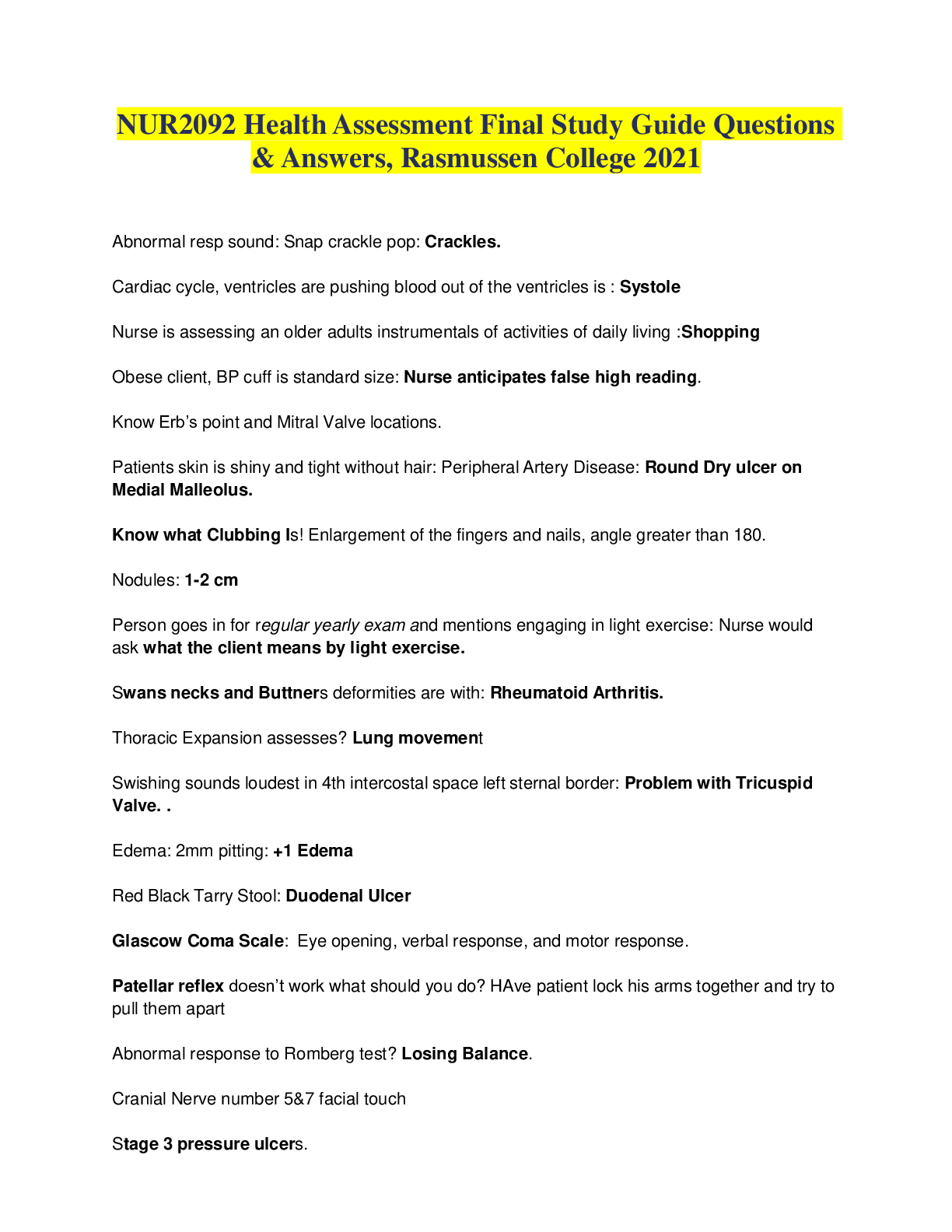
Reviews( 0 )
Document information
Connected school, study & course
About the document
Uploaded On
Sep 23, 2021
Number of pages
39
Written in
Additional information
This document has been written for:
Uploaded
Sep 23, 2021
Downloads
0
Views
57


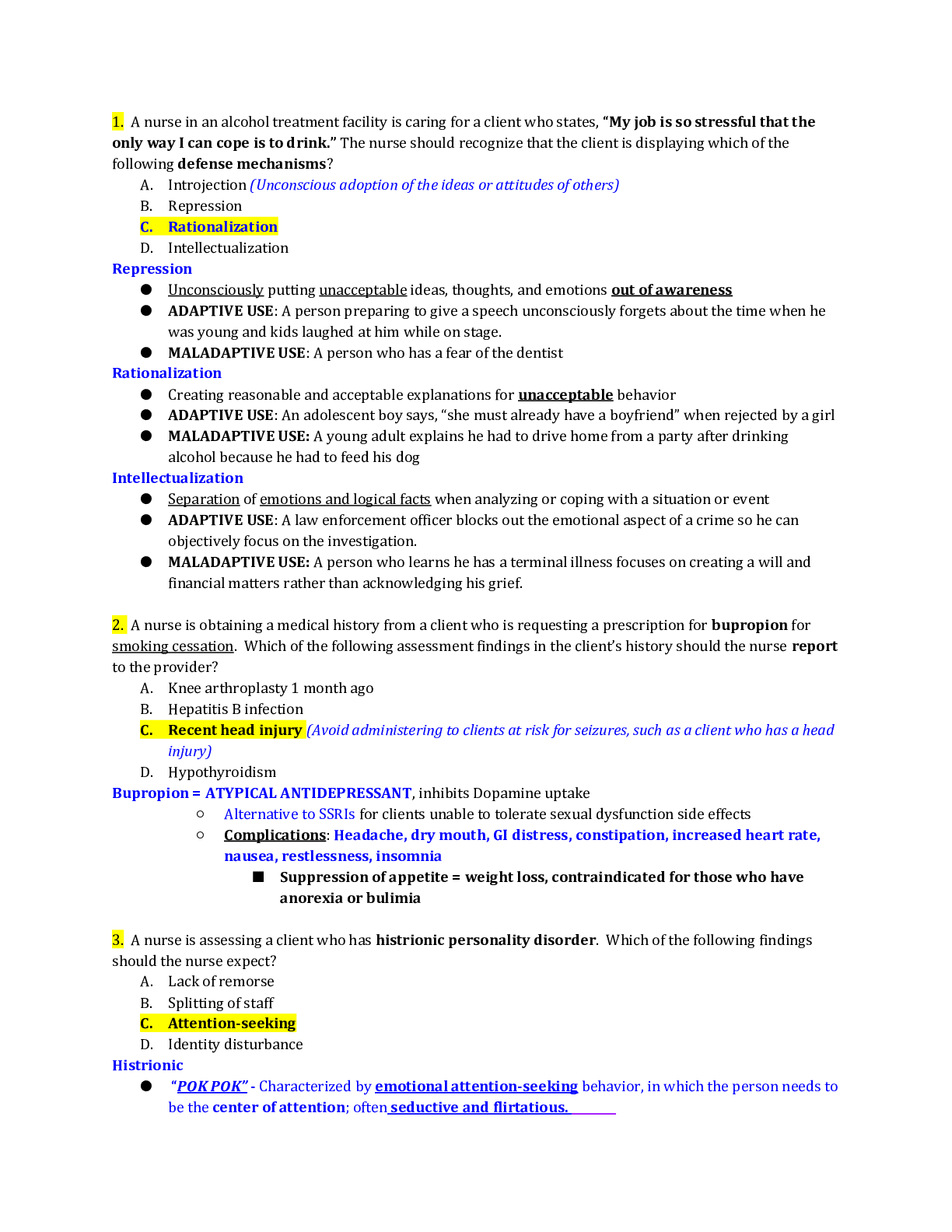
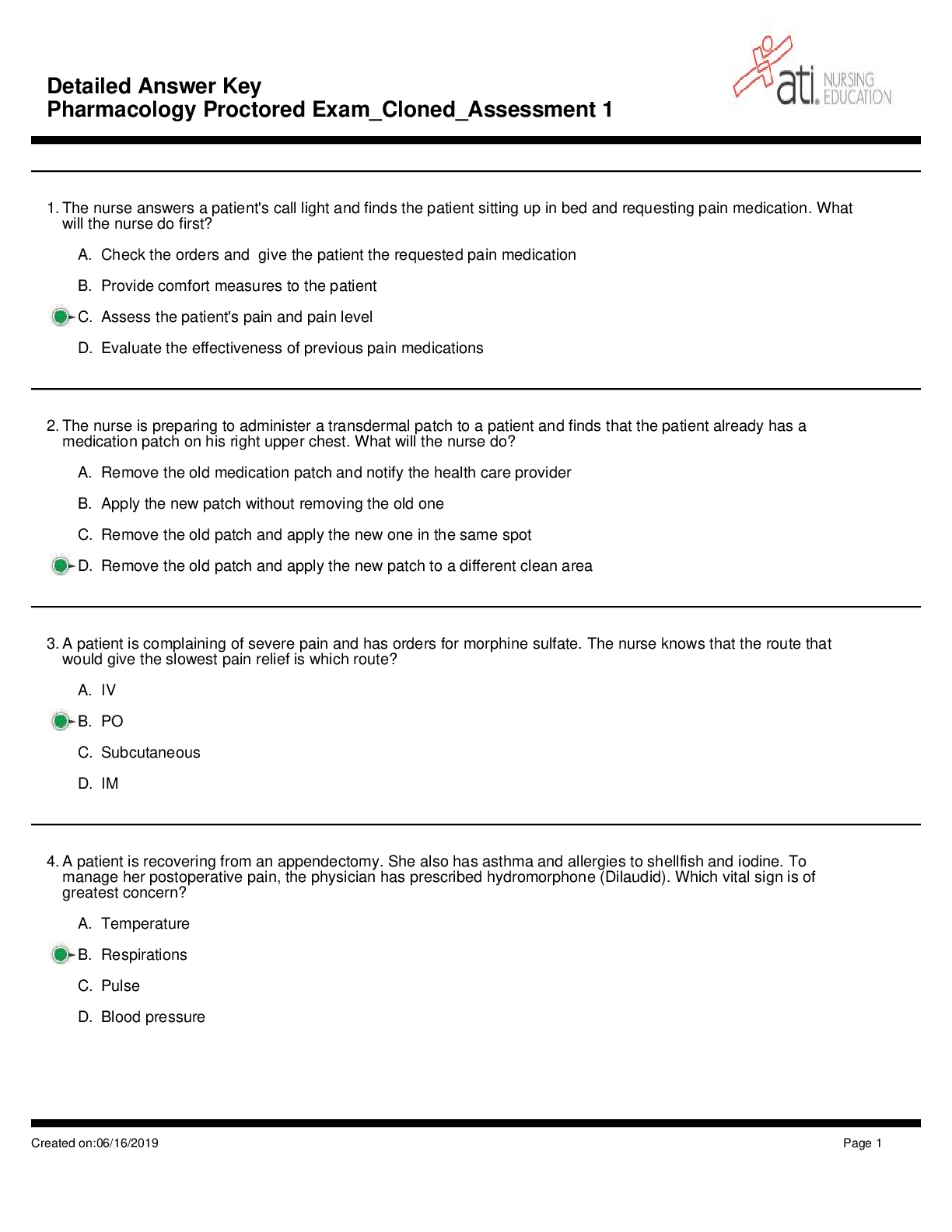
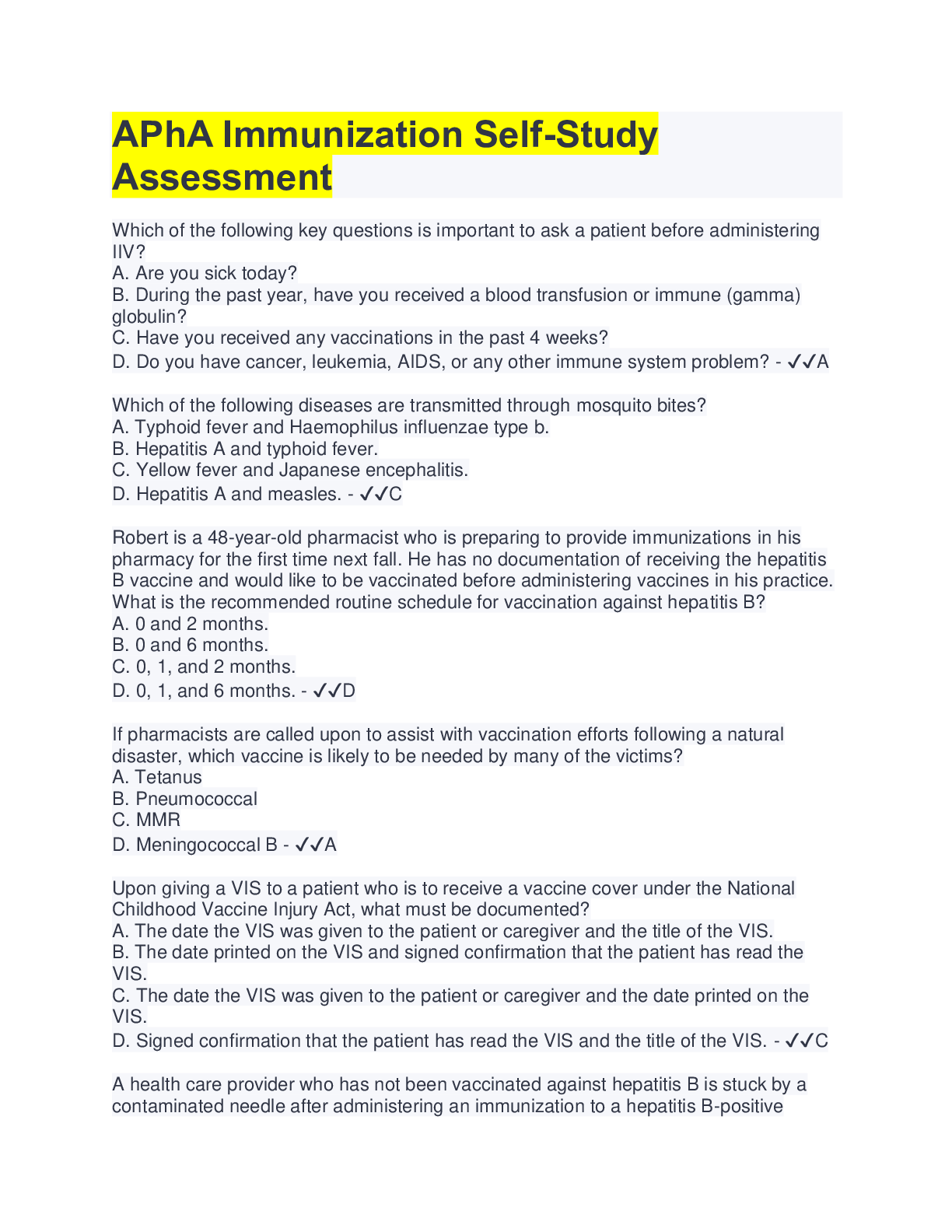
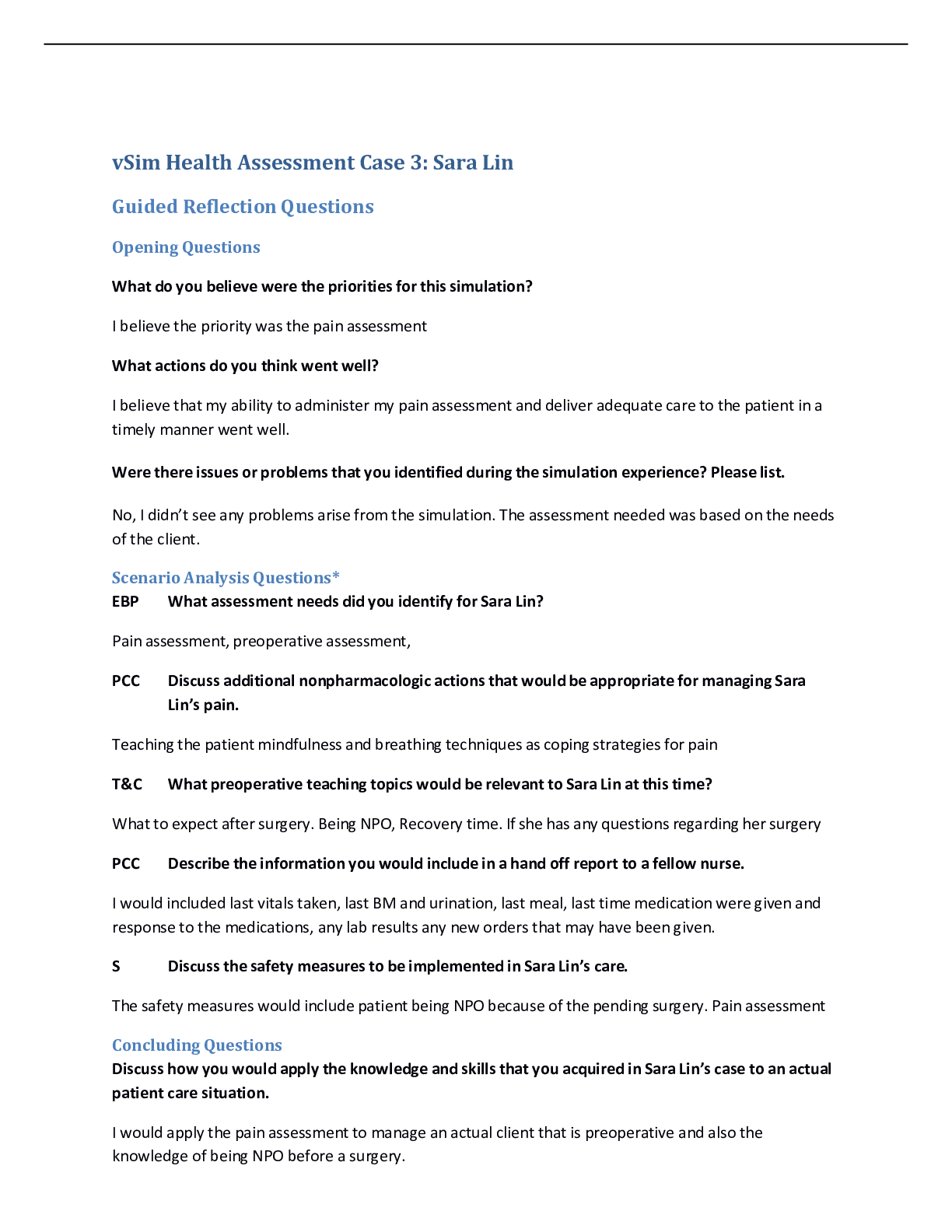
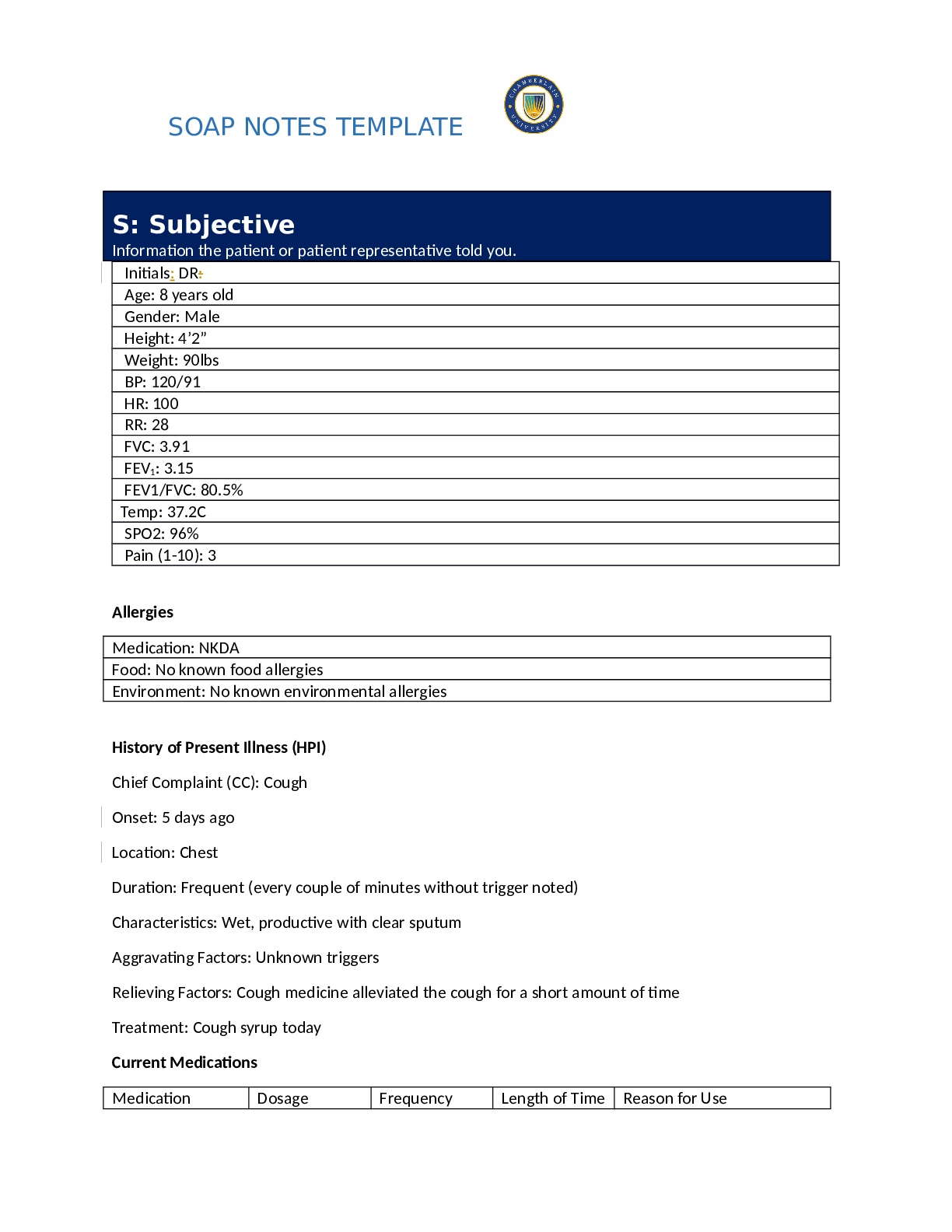

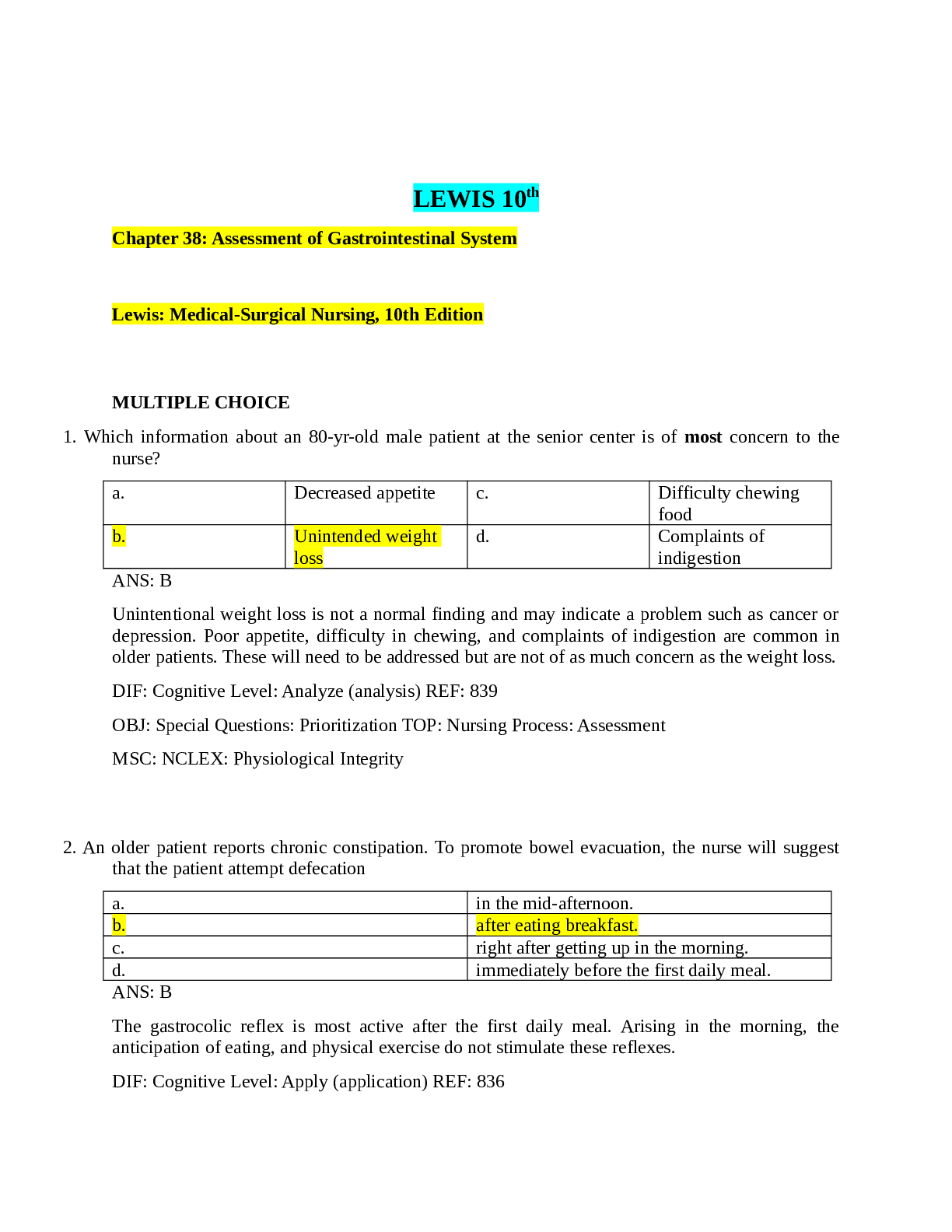


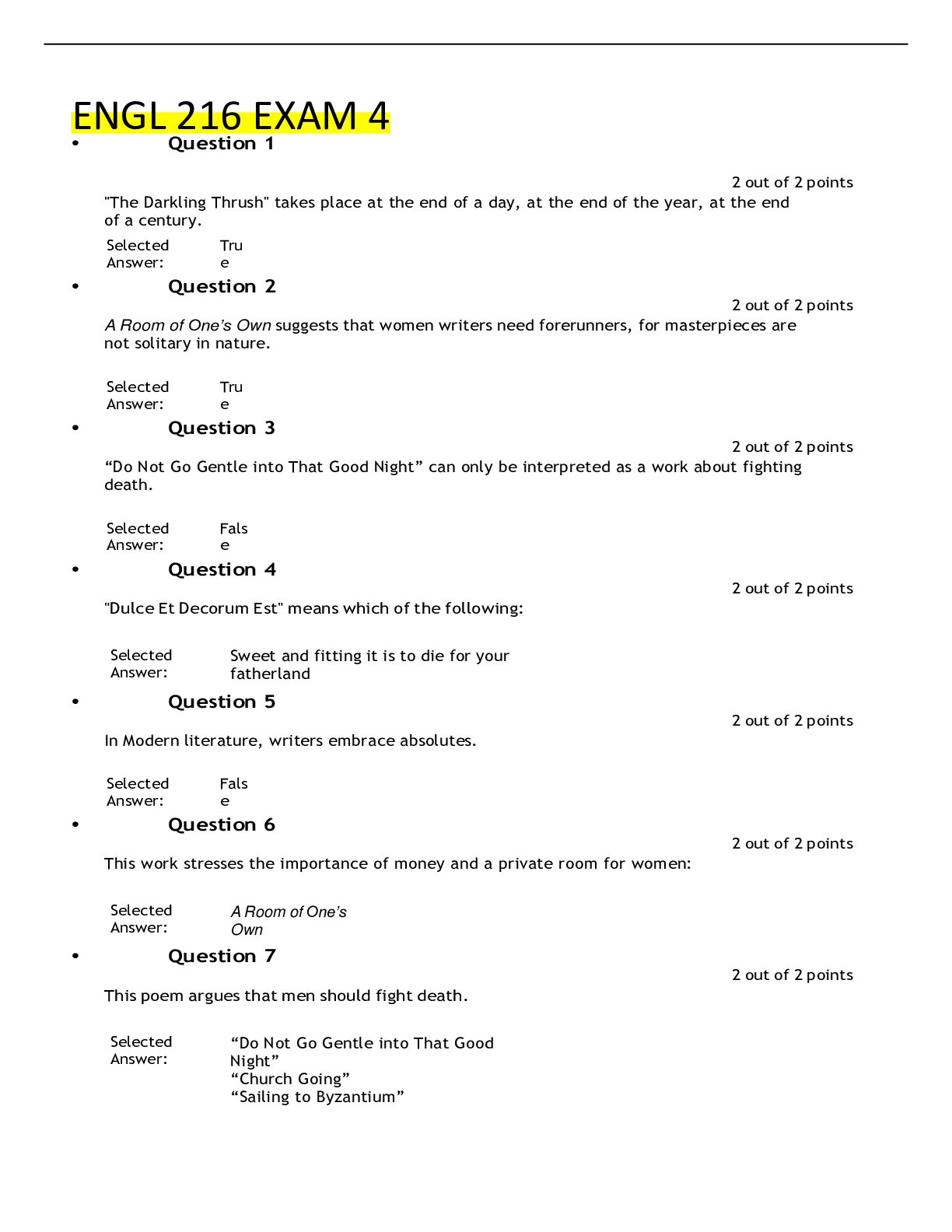
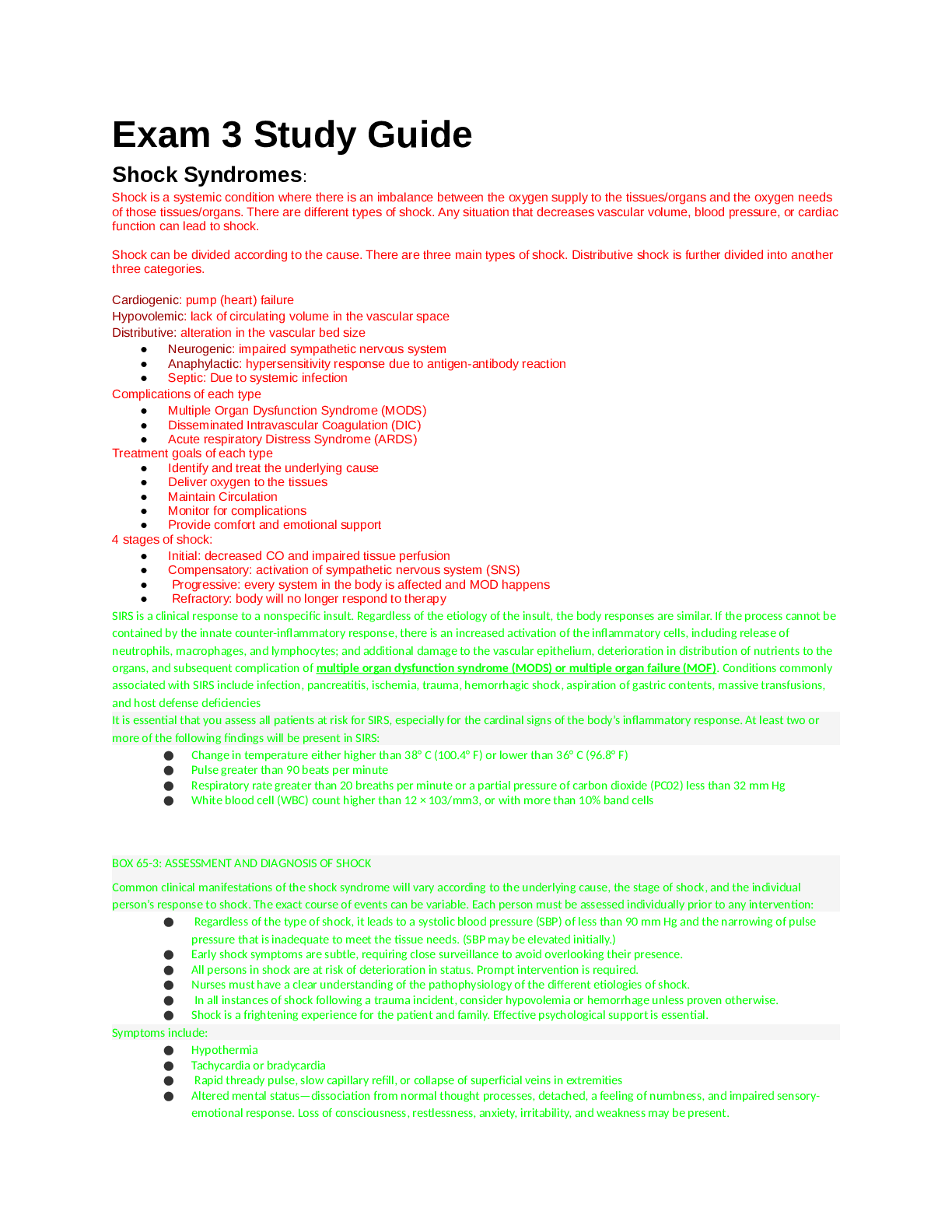

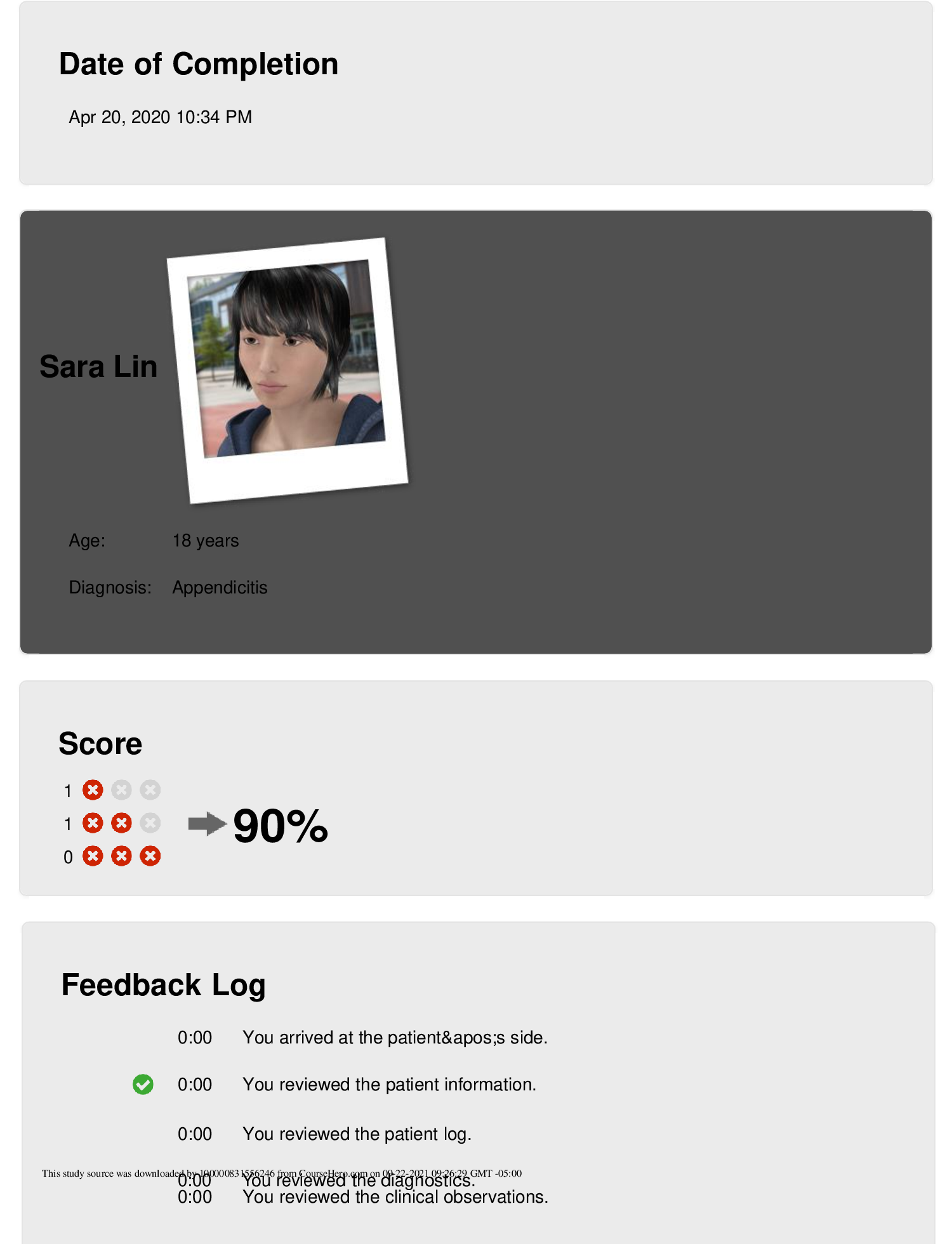

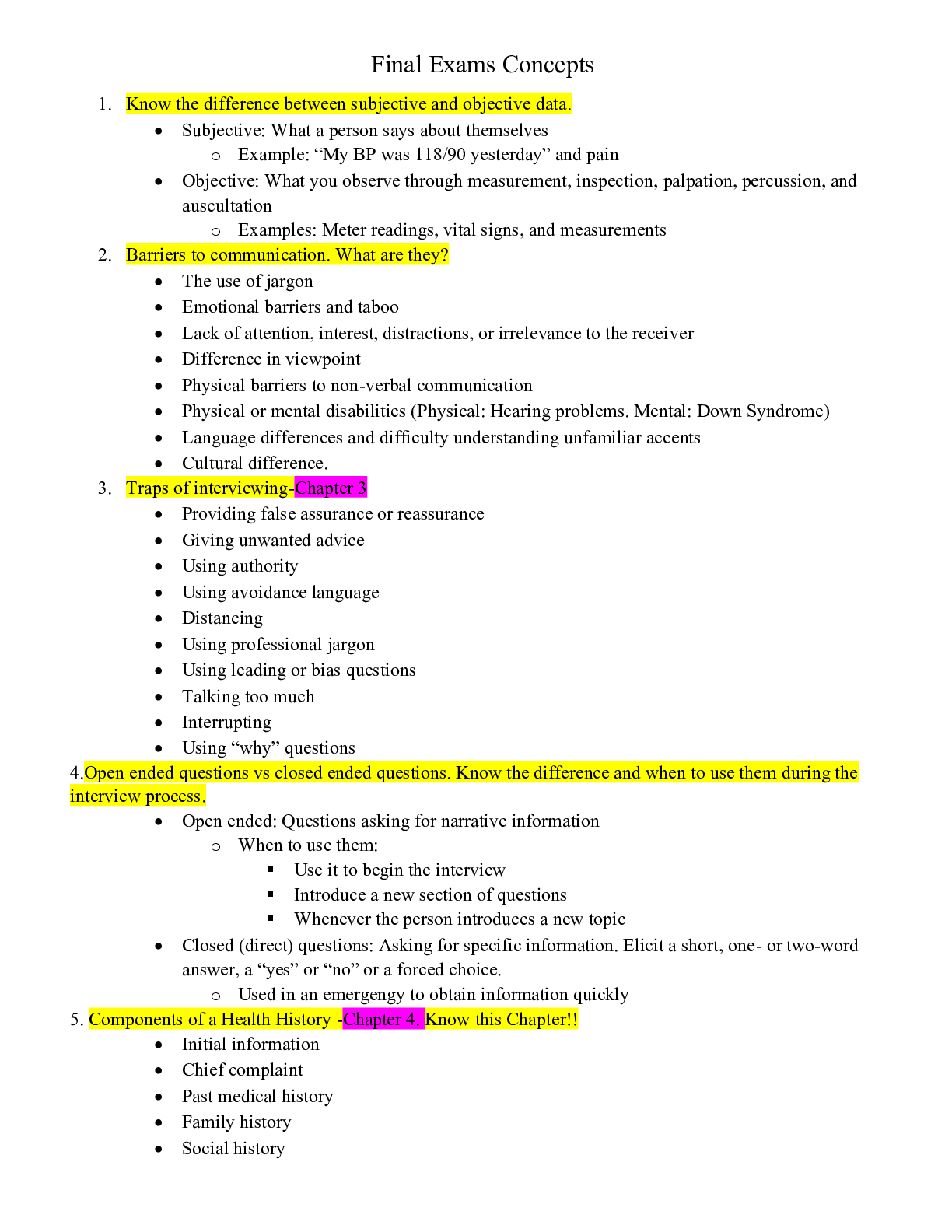

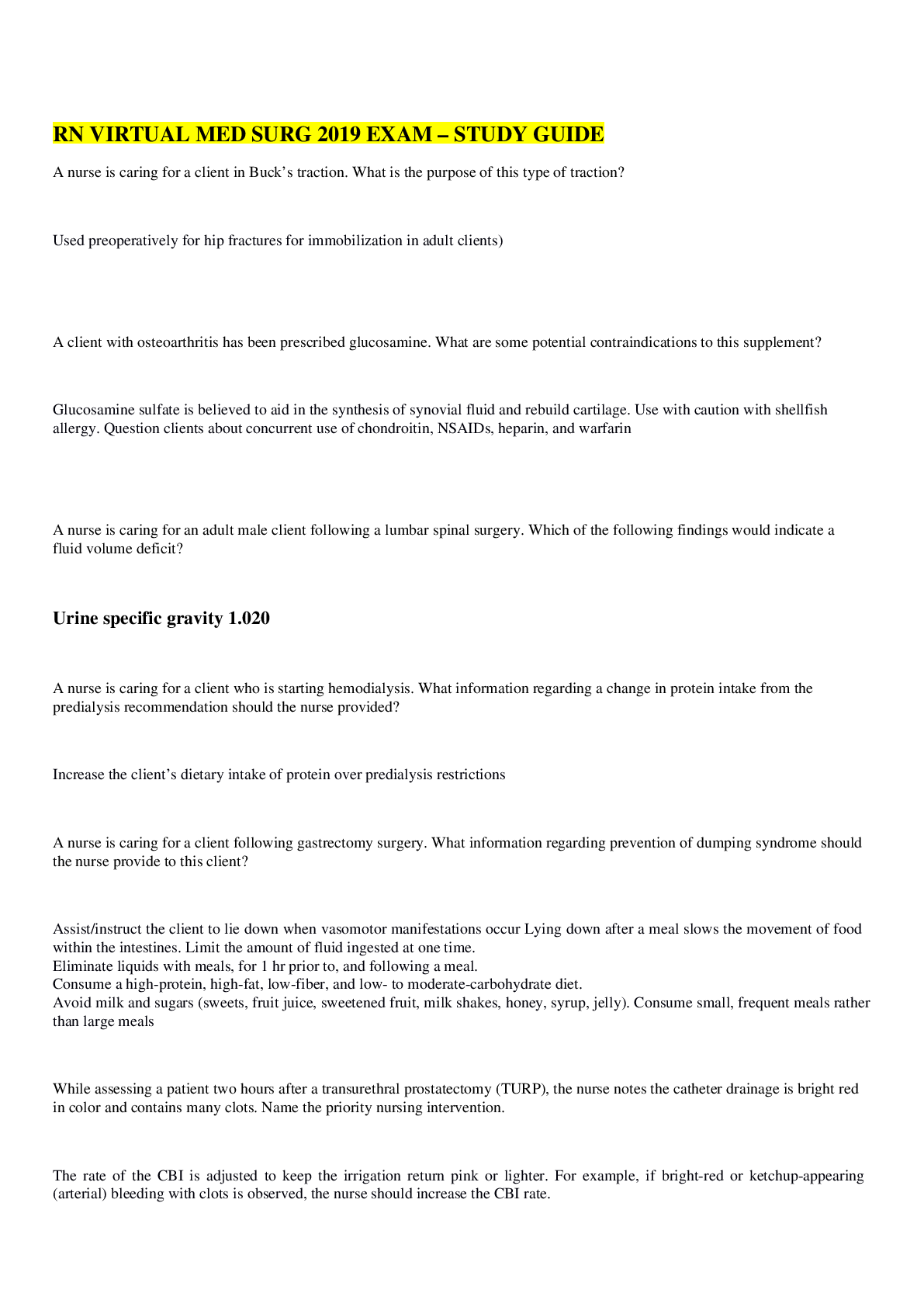
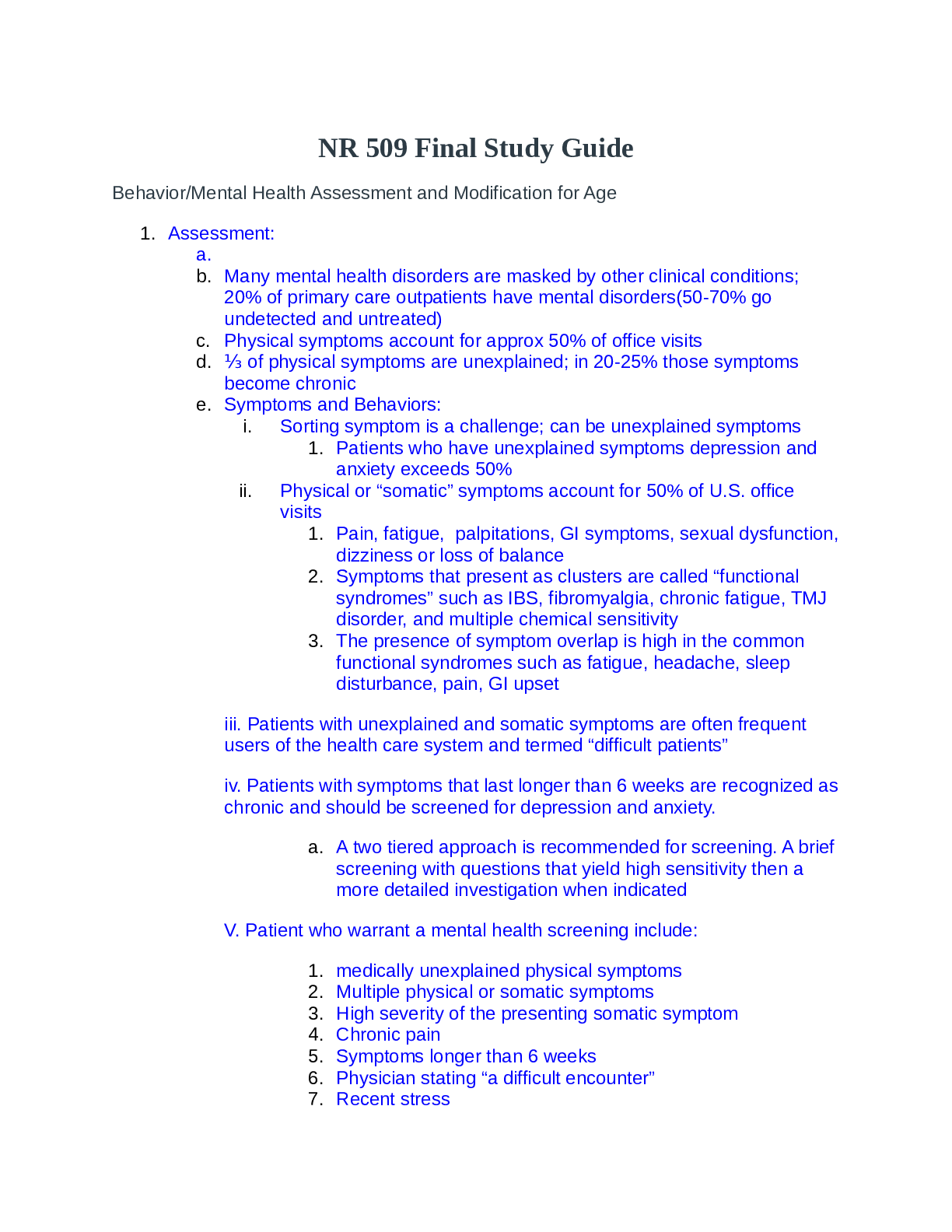
.png)
_patho_201.png)


